All Roads’ Upgrade During Production Keeps Company Green
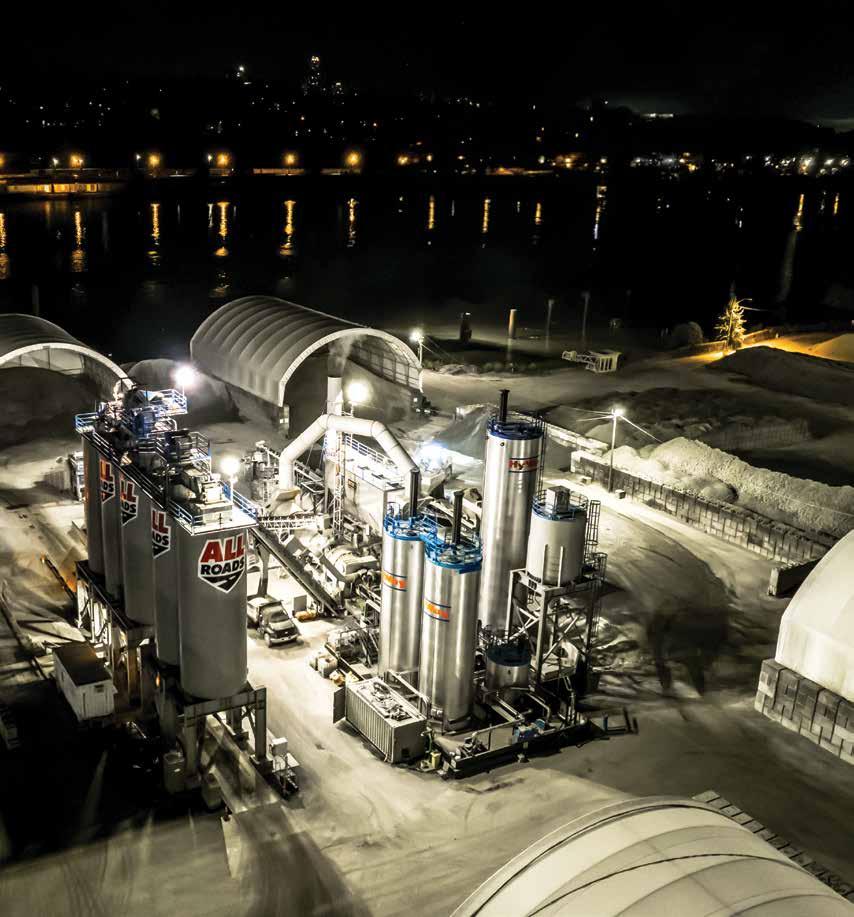
• CRH promotes industry circularity
• More ways to augment your paver
• Solve laboratory materials bans
• Asphalt = resilient Hawaiian airfield
• Hall shares efficient, safe loadout option


• CRH promotes industry circularity
• More ways to augment your paver
• Solve laboratory materials bans
• Asphalt = resilient Hawaiian airfield
• Hall shares efficient, safe loadout option
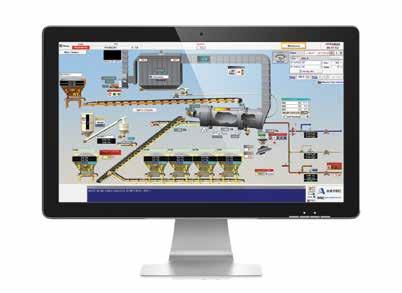

Astec paves the way for sustainable, innovative asphalt plants. The new IntelliPac Moisture System is a revolutionary solution that integrates seamlessly with Astec control systems. This provides unparalleled, real-time visibility into virgin aggregate moisture content. IntelliPac empowers operators to optimize mix design, minimize energy consumption, and reduce environmental impact. With Astec, you get superior asphalt production – better for the environment, better for your business.







6 – Season's Greenings By Sandy Lender
SPOTLIGHT
8 – 5 Trends Shaping Workforce Mental Health and Substance Use Prevention By Cal Beyer
IT UP
12 – Navigating the Transition from TCE in Asphalt Testing By Jason Wielinski, P.E. and Wes Cooper
14 – We Still Need a Good Rotary Depth Crank By Benjamin Everett
16 – Surface Upgrade for Hawaii Military Airfield By Jayanth Kumar Rayapeddi Kumar, P.E., and Jonathan DeHart, PMP, CHST PRODUCER PROFILE
20 – SPT Recycles Asphalt to Reduce CO2 By Jordan Fontaine
OF ASPHALT
24 – Maryland WofA Networks with Paving & Pastries Events By Sandy Lender
72 – ABC Tech Alliance From ABC
74 – Clarifying NCAT’s Role and Findings Reported in the Article “Reverse the Effects of Asphalt Aging After Dark” By Raquel Moraes, Ph.D.

30 – 70% More Storage—No Shutdown Necessary By Sarah Redohl
36 – Augment Your Equipment Achieve precise paving when everyone has what they need, safely at their fingertips By Sandy Lender
40 – CRH’s Sustainable Practices Give Preferred Results By Sandy Lender
48 - Loadout Control Offers Peace of Mind for Hall Contracting By Sandy Lender
50 – Focus on Performance Comparative Analysis of Hot Oil and Electric Heating By Iván Fernández Hevia
55 – AsphaltPro’s 15 Top Products of 2025 By Sandy Lender


As we do each December, we offer a look at sustainable practices throughout the asphalt industry in this issue. I’d like to take the opportunity to discuss consumerism this season, too. Let’s face it, there’s money to be made when greening up the environment, whether with monitoring devices or electrified equipment.
Polaris Market Research reports that the air quality monitoring system market is projected to be worth USD 11.62 billion by 2034; up from USD 5.73 billion in 2024. The research firm states: “An air quality monitoring system is an instrument or collection of instruments...that helps identify impurities such as carbon monoxide, nitrogen dioxide, ozone, particulate matter (PM2.5 and PM10), and volatile organic compounds (VOCs).”
The systems are designed to provide real-time data, which guides environmental management of pollution control measures and so on. Asphalt professionals may be familiar with these devices as a recurring element that citizen environmentalists “quote” at town hall meetings. One of the problems with average citizens erecting such stations to gather ammunition against the local asphalt plant is the average citizen’s lack of science methodology practice. Not every soccer mom understands the impact of Canadian wildfires, the dust plume from the Saharan Air Layer, or twice-daily traffic jams less than a mile from the station on readings. Not every soccer dad is ethical enough to care.
I don’t want to paint a negative picture of our neighbors. I’m sure there are people who want to shut down an established asphalt plant who would not dream of idling a rusted out 1994 Dodge Ram 2500 next to an air quality monitoring station to influence its readings.
Of course, a person would have to look hard to find such a truck. In July and August 2009, the U.S. government distributed about $3 billion in funds for the Car Allowance Rebate System (CARS). This program involved a straightforward voucher given to an individual trading in a not-so-fuel-efficient vehicle to buy a new, efficient one.
Folks in the construction industry can apply that concept to their fleets today with this decade’s incentive programs. Many of the current programs are directed at fleets, operators or businesses, rather than individual consumers. These incentive programs often focus on zero-emission technology rather than just purchasing a more fuel-efficient machine.
For example, the California Air Resources Board launched a voucher program for offroad heavy equipment called the Clean Off-Road Equipment Voucher Incentive Project. This initiative encourages the purchase or lease of zero-emission off-road equipment like loaders, excavators, mobile power units, etc. In New York State, the Truck Voucher Incentive Program, which has expanded to include non-road equipment such as construction, agricultural, etc., of-
fers incentives up to 45% of the base cost when you replace and scrap the gas/diesel equipment.
On the federal level, we have the Clean Heavy-Duty Vehicles Grant Program, overseen by the Environmental Protection Agency (EPA). This isn’t a trade-in voucher program for off-road heavy construction machines like CARS was for consumer vehicles, but a grant program to which businesses can apply, to accelerate replacing internal-combustion heavy-duty vehicles (Classes 6-7) with zero-emission vehicles and their associated infrastructure.
Personally, I drive a 2006 Chevy Cobalt with manual door locks and crank windows. Does it have some rust spots? Sure. I broke the turn signal handle earlier this year because plastic gets brittle over time. I pay a mechanic to keep it running because you’ll have to pry that vehicle out of my cold, dead hands.
Call me all the generational names, but the last thing I want is a car that "conveniently” unlocks the doors for me when I put it in park...in downtown Detroit. Or that shuts off while traveling 55 mph on a remote highway because it detects a pinhole leak in the radiator. I have enough anxiety without adding “range” to it, thank you.
The problem is that the car is old and will need to be replaced, but, thanks to CARS of 2009, simple cars are few, far between, and priced like something out of a science fiction movie.
Is this the direction our construction industry is headed? Will we look back at the mid-2020s when we were trading in tried-and-true machines for 45% off a newfangled electric or hybrid model and wish we hadn’t?
It looks like Michigan DOT has their answer. MDOT conducted research for Fleet Electrification Strategies and recently released Research Report Number SPR-1739 wherein they state: “MDOT was provided with a number of considerations for transitioning its fleet [of 5,000 units] to low- or no-emissions alternatives. These include conducting pilot projects to test electric or hybrid models of a specific unit and evaluate how well they actually perform compared to MDOT’s current gas- or diesel-powered model....Electric-powered versions of these units are available and have been determined to meet MDOT’s operational requirements.” Read the full report online.
No matter how many units from your fleet you feel comfortable replacing to effect cleaner air, this is the edition where we share the sustainability initiatives your peers are also considering and implementing. As we dive into December and the festive green season, the staff at AsphaltPro wishes you and yours a blessed, peaceful, Merry Christmas!
Stay Safe,

Sandy Lender
602 W. Morrison, Box 6a Fayette, MO 65248 (660) 728-5007 • www.theasphaltpro.com
GROUP PUBLISHER
Chris Harrison chris@ theasphaltpro.com
EDITOR
Sandy Lender sandy@theasphaltpro.com (239) 272-8613
DIGITAL EDITOR
Sarah Redohl sarah@theasphaltpro.com (573) 355-9775
MEDIA SALES
Cara Owings cara@theasphaltpro.com (660) 537-0778
ART DIRECTOR
Kristin Branscom
BUSINESS MANAGER
Susan Campbell (660) 728-5007
AsphaltPro is published 11 times per year.
Writers expressing views in AsphaltPro Magazine or on the AsphaltPro website are professionals with sound, professional advice. Views expressed herein are not necessarily the same as the views of AsphaltPro, thus producers/contractors are still encouraged to use best practices when implementing new advice.
SUBSCRIPTION POLICY: Individual subscriptions are available without charge in the United Sates, Canada and Mexico to qualified individuals.
One year subscription to non-qualifying Individuals: United States $90, Canada and Mexico $125.00. For the international digital edition, visit theasphaltpro.com/subscribe/





BY CAL BEYER
The AsphaltPro Magazine was one of the earliest publications in the construction industry to share information on mental health and suicide prevention. I met Editor Sandy Lender when I worked for a hot-mix asphalt (HMA) producer and specialty paving contractor in the Pacific Northwest. In 2017, AsphaltPro published a series of articles authored by me and Dr. Sally Spencer-Thomas on mental health and suicide prevention.
Lender periodically invites me to share updates on industry trends on these topics. Her most recent request was a deep dive to share insights on a “top five current and future trends” positively affecting the mental health and wellbeing of employees in the aggregates and asphalt industries.
The five trends identified in this article reflect the growing expansion of workplace mental health initiatives being increasingly adopted throughout the construction industry. These trends show the increasing need to address the intersection of mental health and substance use to decrease the prevalence of both suicide and overdoses in the industry.
In the 2019 book, The Fearless Organization, Amy C. Edmonson defined psychological safety as “the belief that one will not be punished or humiliated for speaking up with ideas, questions, concerns or mistakes.” Edmonson further described team psychological safety “as a shared belief that the team is safe for interpersonal risk taking.”
Frequently, psychological safety is closely associated with high-risk environments where trust and open communication is essential—from the executive suite to the crew on the ground. This fits the aggregates and HMA industries.
Psychological safety is an essential condition for improving communication, teamwork and problem solving. It grows from intentional team learning of respect and trust, that empowers employees to speak up, share ideas, and take risks, without fear of judgment, criticism, or repercussions.
Psychological safety increases when first line supervisors cultivate open communication and feedback where team members feel comfortable taking risks to give feedback and share ideas without criticism and repercussions. As psychological safety increases so too does hazard reporting and correction, including near miss reporting and a willingness of crews and supervisors to exercise stop work authority.
Psychological safety helps organizations unlock higher performance at the crew, project and organizational level. Companies that intentionally created cultures with shared values for psychological safety evolve into learning systems that reduced friction and conflict, increased collaboration, spurred innovation and problem solving, and decreased incidents and injuries.
Where workers feel greater trust, they are more inclined to seek help for mental health or substance use issues. In short, when crews feel psychologically safe, they’re more willing to speak up—not only about job hazards, but also about personal struggles. Psychological safety is a pre-
cursor for promoting workplace well-being, the intersection between physical health and emotional wellness.
An important way to boost psychological safety is to educate the workforce about how common substance use challenges are—and the services and supports available for prevention and recovery. This serves to decrease stigma and promotes help-seeking leading to recovery. The Recovery Research Institute (RRI) defines recovery from a substance use disorder as “a process of improved physical, psychological, and social well-being and health after having suffered from a substance-related condition.”
Traditional approaches to substance use prevention in the workplace do not result in employees or family members receiving services. Historically, companies took a “hands-off” approach to substance use in asserting it is not the business of businesses to care what people do in their time away from work unless it becomes an issue at work. Unfortunately, this passive approach did not acknowledge how common substance use challenges were, and did not recognize how important it is for employers to support employees seeking support and services for substance use treatment and recovery.
In industries under the jurisdiction of Federal Highway Administration (FHWA) Department of Transportation (DOT) regulations for safety sensitive positions, companies have historically relied on Drug Free Workplace policies and drug and alcohol testing protocols. Often these programs are punitive in nature, and result in disciplinary actions, including loss of employment. This reinforces stigma about mental health and substance use and keeps people from being comfortable seeking or asking for help.
It is important to teach all employees about substance use and misuse. It is important to focus on prevention and early intervention with family members to minimize crises relating to worsening substance use disorder. By offering training on Recovery First-Aid and Recovery Allyship, workplaces can provide a necessary safety net to help employees and family members needing vital support. (See the SAFE Project website for information on Everyday Etiquette for Recovery Allies).
In 2018, the state of New Hampshire became the first to adopt a Recovery Friendly Workplace (RFW) program. As of 2025, over 25 states have adopted various versions of RFW programs or initiatives. There is even a national certification program sponsored by the National Recovery Friendly Workplace Institute.
A primary purpose of RFWs is to expand labor rate participation by increasing the recruitment and retention of persons in recovery. There remain significant levels of stigma around substance use and addiction. This creates bias and judgment resulting in potential discrimination for persons in recovery in the hiring process. This can include being passed over for promotions and other career advancement opportunities.
2 0 2 6

For over a half a decade Blaw-Knox has earned its reputation as the go to source of training and instruction on hot mix paving.
The Blaw-Knox University, is dedicated to training paver operators and foreman on proper Paver Operation and Maintenance and applied Best Paving Practices through classroom-style and handson application courses.
Blaw-Knox provides improved technical and problem-solving skills on a variety of paver operations and maintenance topics. Course instructors share decades of field and teaching experience with attendees, including training on the latest DOT requirements.
• January 12 - January 15
• January 19 - January 22
• January 26 - January 29
• February 2 - February 5 2026 DATES
All details can be found at www.blawknox.com/training or contact at (407) 290-6000 ext. 342 or training@blawknox.com

When employers commit to being an RFW, they create a safe space for employees and their families to seek care—without fear of judgment or career consequences. The organization is encouraging employees to seek help and support and ensuring access to necessary services.
There are many emerging pockets of success that point to the benefits of this innovative program. Successful RFW programs highlight decreased absenteeism, lower turnover, improved workplace trust and engagement, and higher productivity by hiring persons in recovery.
Despite the growth of the RFW movement, awareness remains a challenge. A survey in September 2024 by consulting firms ForsMarsh and the Human Resources Certification Institute highlighted “60% of human resources professionals had never heard of recovery-friendly workplaces before this survey.” One source of confusion can be that RFW is called Recovery-Ready Workplaces by the federal government and as Workplace Supported Recovery by the National Institute of Occupational Health in its Total Worker Health initiative. Fundamentally, all three names refer to the same approach.
RFWs are an opportunity for the construction industry to close the shortage of skilled and unskilled labor by providing fair chance employment opportunities. The RFW movement offers the industry a positive way to reduce stigma and provide meaningful improvement to help employees and their family receive support and services to address problematic substance use.
According to data from the Centers for Disease Control and Prevention (CDC), the construction industry has the highest rate of overdose deaths among major occupations. Long hours, physical strain injuries and access to prescription opioids can create a dangerous mix for workers, many of whom are trying to manage chronic pain while showing up for the job.
Preventing the first exposure to opioids starts with strong injury prevention programs—especially for soft tissue injuries from material handling, falls, vehicle incidents and struck-by hazards. It is especially important for companies to focus on the prevention and management of soft tissue injuries frequently occurring in material handling tasks, slips/ trips/falls, motor vehicle incidents, or being struck by or caught between moving objects.
Naloxone, also known by the brand name Narcan, is a life-saving medication that reverses opioid overdoses, and is just as essential for a first-aid kit as an automated external defibrillator (AED). SAFE Project encourages all employers to provide another layer of protection for workforces by breaking the stigma that surrounds overdose response and equipping job sites and field teams with naloxone.
Naloxone works by blocking the effects of opioids in the brain, restoring normal breathing in minutes. It does not affect someone who hasn’t taken opioids and is safe to administer in emergencies. Yet overdoses rarely happen the way Hollywood portrays them. Most occur in homes, bathrooms or parked vehicles. Some happen at work; in fact, 10% of job site fatalities are overdoses. They often involve fentanyl—a synthetic opioid up to 50 times stronger than heroin—hidden in pills or powders without the user’s knowledge.
SAFE Project commends Vulcan Materials Company for its bold action in 2025 to stock naloxone at all company workplace locations. While stocking naloxone is still relatively new in the industry, early adopters are setting the tone for a culture that treats overdose prevention like any other workplace safety measure. Vice President of Safety, Health and Envi-
ronmental Chad McDougal advised that Vulcan Materials deployed naloxone at over 550 locations. (See article featuring Vulcan Materials posted on the SAFE Project website).
Increasingly, more contractors are training their workforces in suicide prevention as part of their safety and wellness programs. VitalCog is a brief, evidence-informed suicide prevention training tailored for the construction industry. VitalCog in Construction was co-developed by the University of Colorado’s Helen and Arthur E. Johnson Depression Center, United Suicide Survivors International and LendLease.
VitalCog in Construction is becoming a training of choice that equips first-line supervisors and crew members with the skills to recognize common warning signs, how to hold direct conversations and connect peers to support. VitalCog in Construction is available in both English and Spanish.
VitalCog can be completed in a period of one to two hours and captures valuable data in post-training surveys. Research reported in the Journal of Workplace Behavioral Health showed attendees experienced increased confidence identifying suicide warning signs and a significant rise in comfort talking about suicide and offering resources. An increasing number of trainers throughout the construction industry are offering VitalCog in Construction. Learn more at: https://vitalcog.com/suicide-prevention-in-construction/
Cal Beyer, CWP, NAC is the senior director of SAFE Workplaces for national nonprofit SAFE Project (SAFE stands for Stop the Addiction Fatality Epidemic). He has 35 years’ experience as a safety, wellness and risk management professional and is an advocate for workplace mental health, suicide and overdose prevention, and recovery. He helped launch the Construction Industry Alliance for Suicide Prevention (CIASP) in 2016. He is a 2025 inductee of the National Academy of Construction. For more information, visit www.safeproject.us or contact him at cal@ safeproject.us or (651) 307-7883.
If you are interested in learning more about these trends in workplace mental health, consider attending the 5th annual Construction Mental Health and Wellbeing Conference in Portland, Feb. 23-26, 2026. The main conference is held on the final two days.
• Monday, Feb. 23: Optional Pre-Conference Storytelling Retreat & VitalCog Instructors Convening
• Tuesday, Feb. 24: Optional(?) Pre-Conference Workshop Sessions
• Wednesday, Feb. 25: Mental Health & Suicide Prevention
• Thursday, Feb. 26: Addiction Treatment, Recovery & Overdose Prevention
For more information: https://www.unitesurvivors.com/ construction-mental-health-wellbeing-conference/#2026


Your first stop in the FAYAT GROUP road lifecycle, ADM makes the plants that make the hot mix. When it comes to North American roadbuilding, FAYAT Group brands including ADM, BOMAG, Dynapac, LeeBoy, and Mecalac have you covered.
See a totally new EX Series asphalt plant at ConExpo/ConAGG March 3-March 7.


BY JASON WIELINSKI, P.E. AND WES COOPER
Editor’s Note: Reporting around the industry in late summer 2025 may have added some confusion to the discussion of when trichloroethylene (TCE) was banned. As early as Dec. 21, 2023, AASHTO petitioned EPA to grant the industry a 20-year phase-out period to allow state DOTs time “to investigate alternative methods for asphalt testing with the goal of eliminating TCE from their testing protocols.” By Dec. 17, 2024, our industry was included in the final ruling’s 10-year phase-out period. See paragraph two below for more detailed information.
The Environmental Protection Agency (EPA) proposed a rule in 2023 to prohibit the production and use of trichloroethylene (TCE) in many industrial applications, including asphalt testing. After a period of comment review and discussion, the EPA published its final ruling in December 2024 in favor of a TCE ban.
To alleviate issues with immediately banning TCE from asphalt labs, a phase-out period has been identified: five years for open systems (this would include centrifuges and reflux systems used in binder extraction from asphalt mixtures) and 10 years for closed systems (this would include auto-extractors). However, those organizations continuing to use TCE during this phase-out period will be required to monitor and document procedures on training employees and establishing a Workplace Chemical Protection Program (WCPP).
The transition away from TCE will affect asphalt laboratories in several ways, including binder solubility testing and solvent-based extraction and recovery. Fortunately, options are available to asphalt labs to make the necessary adjustments in light of these rulemaking directives and concerns. To that end, the following insights are offered from the Asphalt Institute as a means of assisting asphalt test labs during the transition away from the use of TCE.
TCE is still the primary solvent used for ensuring that an asphalt binder is relatively free of non-organic mineral matter. The two most common test methods for this type of determination (often referred to as the “Solubility Test”) are AASHTO T 44 (Solubility of Bituminous Materials) and ASTM D2042 (Standard Test Method for Solubility of Asphalt Materials in Trichloroethylene or Toluene). AASHTO T 44 lists TCE or trichloroethane (TCA) as the allowable solvents, while ASTM D2042 permits both TCE and toluene. Of the two test methods, AASHTO T 44 is the most widely used in the United States but is the most restrictive in that it only allows for the use of chlorinated solvents.
In 2016, AASHTO T111 (Standard Method of Test for Mineral Matter or Ash in Asphalt Materials), commonly referred to as the “Ash Test,” began to replace solubility testing in AASHTO specifications for anionic, cationic and polymer-modified asphalt emulsions. ASTM emulsified asphalt specifications followed suit in 2020, allowing for the use of either D2042 or D8078 (Standard Test Method for Ash Content of Asphalt Binder and Emulsified Asphalt Residues). A primary reason for this change was to eliminate testing difficulties related to polymer-modified
If your organization relies on trichloroethylene (TCE) for asphalt tests, the immediate priorities are these:
• Implement the required workplace chemical protection program (WCPP) and exposure controls now, keeping in mind the TCE rule’s Workplace Chemical Protection Limit (WCPL) states airborne exposure cannot exceed 0.005 ppm (over 8 hours).
• Begin validating alternatives or engineering controls (especially to avoid manual centrifuge uses before December 2029).
• Track state DOT or state environmental guidance (states may add additional requirements or timelines).
At this time. Start by confirming that your lab’s use of TCE falls under “laboratory chemical for asphalt testing and recovery,” then assess your equipment. Identify all equipment and methods using TCE, such as centrifuges, vacuum recovery, asphalt binder extraction, etc.
Also assign a responsible official or Chemical Hygiene Officer to oversee your TCE phase-out and worker-protection compliance. When implementing your WCPP, develop and maintain written records that cover:
• Engineering controls (fume hoods, closed-loop extraction systems, solvent recovery enclosures);
• Administrative controls (restricted access, time limits, cleaning schedules);
• PPE program (respirators with organic vapor cartridges, gloves, chemical-resistant lab coats);
• Exposure monitoring and medical surveillance; and
• Recordkeeping (SDSs, exposure logs, training records).
By December 2029. Discontinue TCE use in manual centrifuges for asphalt recovery. Replace it with closed-loop or automated extraction systems using alternate solvents (like those approved in ASTM D8159). Make sure you document your conversion or discontinuation.
By December 2034. All TCE use for asphalt testing and recovery must end. Identify and validate alternative solvents or solventfree recovery methods. Validate new methods through ASTM or AASHTO standards and your client/state DOT specs. And make sure you document it all. Maintain records of solvent substitution testing and approvals, notifications to clients or DOTs about method changes, and all equipment modification and/or decommissioning. As every good lab should do, follow your ongoing best practices, too.
• Keep up with your emergency procedures: Maintain spill kits, eyewash stations, and first-aid plans specific to chlorinated solvents.
• Double-check your ventilation systems: Inspect and certify hoods or local exhaust every six months.
• Manage waste: Dispose of TCE waste as RCRA hazardous waste (F002 listing).
• Communicate: Ensure vendors are aware of the EPA ban timelines.
residues. For example, latex-modified residues are known to “gel” on the crucible during solubility testing, plugging the filter pad and making the test procedure difficult or even impossible to perform. Like solubility testing, the Ash Test is meant to ensure that paving binders and emulsified asphalt residues are relatively free of mineral matter. Whereas the Solubility Test involves dissolving organic matter with a solvent, the Ash Test uses a muffle furnace to incinerate all organic material, leaving behind a percentage of inorganic mineral matter. The Ash Test procedure accommodates more complex binders while removing the risks associated with the use of chlorinated solvents.
The impact of the TCE ban may be felt more acutely for labs who perform solvent-based extraction and recovery of binder from asphalt mixtures. One alternative is to replace the use of TCE with toluene as outlined in ASTM D2172 (Standard Test Methods for Quantitative Extraction of Asphalt Binder from Asphalt Mixtures) and ASTM D7906 (Standard Practice for Recovery of Asphalt Binder from Solution Using Toluene and the Rotary Evaporator).
Toluene does not carry the same long-term exposure risks as TCE and is thought to be easier to remove from the binder during the recovery process. However, the flash point of toluene is notably lower than TCE (around 40°F); thus, labs must ensure that storage and handling procedures are updated, and engineering controls are put in place to mitigate any fire risk. For many agencies and organizations, the increased flammability risk makes toluene a non-starter. Additionally, the low flash point means that toluene is incompatible with the closed-loop systems used in auto-extractors.
Where does this leave labs who depend on auto-extraction systems? ASTM D8159 (Standard Test Method for Automated Extraction of Asphalt Binder from Asphalt Mixtures) currently allows for the use of tetrachlorethylene (PCE) and methylene chloride (DCM) as suitable alternatives. Like TCE, PCM and DCM are chlorinated solvents that carry their own risk to human health; if labs make the switch to either of these solvents, care should be taken, including proper personal protective equipment (PPE) such as appropriately rated chemical-resistant gloves, exposure monitors and solvent respirators. Engineering controls are also vital, including walk-in fume hoods to house extraction systems or snorkel vents that limit exposure to fumes.
Implementation of changes will be context-specific, and while innovation may lead to any number of viable alternatives, it will likely take time for these to emerge in the market. Undoubtedly, there will be more questions to arise and challenges that the asphalt industry will face over the course of the TCE transition period. Working together and sharing knowledge can help everyone who depends on these solvents for accurate binder characterization and quality control.
Jason Wielinski is an Asphalt Institute regional engineer based in Ohio. Wes Cooper is the laboratory manager and senior research scientist at the Asphalt Institute Laboratory in Lexington, Kentucky.


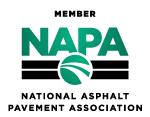
BY BENJAMIN EVERETT
here is an adage: “If we always do what we always did, we’ll always get what we always got.” Now this subject is all about the reason (as I see it) for the screed rotary depth cranks (or screws) and why they’re included on U.S. style screeds but not on European screeds. Why does one European paver and screed manufacturer not even install threaded adjusting screws on the screed at all? Let’s look at why these are important and when and why you should use them. There are a lot of fundamental misconceptions around the above, which I would like to use to stimulate conversation.
To clarify my thoughts, I am not suggesting that there shouldn’t be a manual, rotary depth crank on the screed. I absolutely believe there should be as it is essential for balancing the screed and keeping the nose in the ideal attitude.
I like to think of the depth cranks as being very similar in operation and theory to the rear horizontal stabilizer and elevator that you find on the tail of most modern jet airplanes. Basically, the elevator is adjustable (just like a rotary depth crank) and is the method that the pilot uses to maintain the optimum, slight nose-up attitude or horizontal pitch of the airplane during flight. It’s always slightly nose-up to give lift; just like a screed.
A motorboat is usually fitted with a similar device called trim tabs. These are right at the rear end of the hull and are also used to adjust the planing angle of the craft to also create a slight nose-up attitude. This is the same principle a screed requires to float.
We require a means to adjust and dial in the optimum angle of attack to provide a tight, dense mat texture. I believe though, once you have established this optimum angle of attack (1/8-inch to ¼-inch slight noseup typically), you shouldn’t start messing with that setting during normal paving operations. This procedure should be done at the start, then left alone.
Because if you use the depth crank instead of the tow point, invariably you will
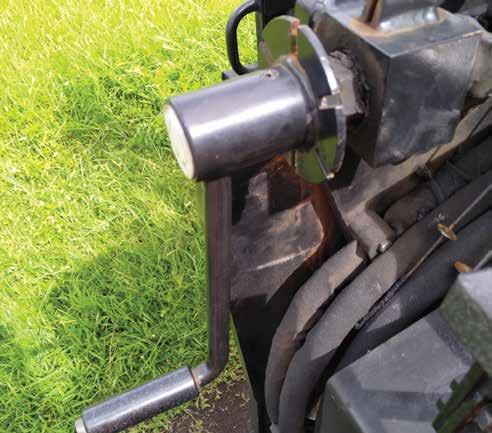
upset and change that initial, ideal slight nose-up angle of attack. This can lead to the screed planing on a less than ideal angle of attack (either nose-up too high or low), which can result in a variable mat texture, transition lines and in extreme cases, excessive and uneven wear to the leading edge or rear tail of the screed with uneven compaction. This will often create issues like the screed being difficult to control and a poor mat texture.
I had this discussion with a well-known industry expert from a leading original equipment manufacturer (OEM) at World of Asphalt in 2024. He basically agreed with me and believed the reason so many operators use the depth cranks to adjust mat depth, rather than using the tow points,
comes down to tradition; or “we’ve always done it that way.”
I don’t advocate removing the depth cranks (as one OEM does on the European tamping screeds it makes) or taking the handle off and leaving an adjustable threaded rod (like most E.U. screeds have), as that creates other problems. I’ve seen people using the screed at an incorrect angle of attack for a certain mat depth it was not set up to achieve because adjusting the threaded rod was difficult or they didn’t have the wrenches on site to make adjustments. That’s just as bad as playing with the cranks and changing the pitch during paving.
Also, I absolutely agree with using the depth cranks to “buy back cylinder” in certain situations such as when following a variable grade or using slope on one side. I do that myself when required so it’s important to have depth cranks for this.
What I’m suggesting is once the operator has established and dialed in the correct angle of attack, after checking the screed is planing at an ideal angle and the screed pivot point is fairly parallel to the tow point pin, he or she will use the tow points to adjust mat depth after that (in both manual and automatic) and leave the cranks alone. After all, if you carefully think about the concept and practice of correctly setting the screed pitch or angle of attack, you want to maintain that ideal setting, not change it.
I appreciate that some folks will almost certainly have strong views either way about this, and that’s a good, healthy subject to discuss. I recall about 15 years ago, I first obtained a copy of the asphalt “Bible” I regularly consult. This is the same U.S. Army Corps of Engineers’ “Hot-Mix Asphalt Paving” handbook 2000 (AC 150/5370-14A Appendix 1) I referred to in my previous article “Control the Feed to Control the Screed.” At that time, I had been full time in the asphalt industry for around 25 years, and I had been taught in the mid ’80s how to compact asphalt in the “old school way.”
This procedure involved “nipping the joint” or basically rolling the longitudinal joint match first by about 1 to 2 inches to push the joint down so it looked nice. I thought that was the only way and the right way.
However, upon reading this handbook, I discovered in the compaction section that the old method was no longer a best practice. It was not a recommended procedure due to quality issues that methodology often created. Well, it caused me a great deal of personal angst, and I struggled with the concept that what I had done for 25 years was now “wrong.” And it took me about three years to accept the idea. It was kind of like I was thinking to myself, “You mean to tell me I’ve been doing it wrong for the past quarter century?!”
But sometimes you have to reconcile yourself to realizing that as time passes, often new knowledge, learning and understanding of evolving processes can come to light. Now, I’m a complete convert in the current U.S. best practice compaction methodology. I realized eventually that what I had been doing
for all that time wasn’t “wrong” for that time. Instead, knowledge evolves over time, and we all must be prepared to re-evaluate some things if new lessons come to the fore.
After all, it was George Bernard Shaw who so accurately stated: “Progress is impossible without change, and those who cannot change their minds cannot change anything.”
Let me know what you think about the use of rotary depth cranks and tow points
and other long-held paving practices. It’s a challenging vocation we share, and it’s not for everyone, but I wouldn’t trade it for anything.
Benjamin Everett is the owner of About Asphalt Ltd., and has worked in the asphalt industry for nearly four decades. For more information, contact him at bjeverett@ aboutasphalt.co.
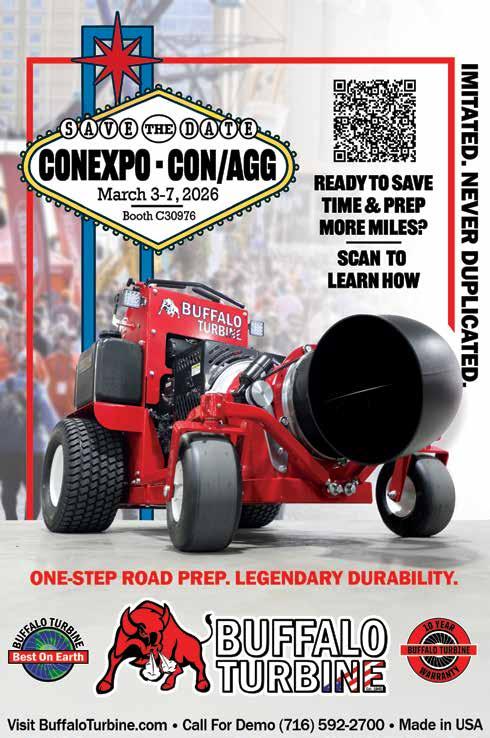
BY JAYANTH KUMAR RAYAPEDDI KUMAR, P.E., AND JONATHAN DEHART, PMP, CHST
Nestled high on the saddle between Mauna Kea and Mauna Loa mountains on Hawaii’s Big Island is the Pohakuloa Training Area (PTA). Located over 6,000 feet above sea level, PTA is the largest U.S. military training ground in the Pacific. The base is also home to Bradshaw Army Airfield, which has an asphalt runway (designated 9-27) approximately 3,700 feet long and 108 feet wide. Originally constructed in the mid-1950s, the aging runway required upgrades to meet the evolving needs of the U.S. military. To address this, the U.S. Army undertook the effort to rehabilitate the runway and upgrade key airfield infrastructure. The project was awarded to Hawaii-based Elite Pacific Construction, Inc. (EPC), who served as the general contractor. EPC partnered with Jas. W. Glover, Ltd. (JWG)— also a Hawaii-based general contractor, construction materials supplier, and paving contractor—to perform the runway rehabilitation work. While the project addressed many aspects of the airfield’s infrastructure, this article will focus specifically on the runway’s condition prior to rehabilitation, as well as the challenges and successes encountered in the mix design, production, and placement.
Before rehabilitation began, the runway was assessed for both smoothness and the extent and severity of cracking. Smoothness was measured using the Profile Ride Index (PRI) with a California-type Profilograph. Results showed that the center portion of the runway had a PRI of approximately 20 inches per mile. However, PRI values increased significantly toward the edges, reaching up to 70 inches per mile in some areas.
Due to site conditions, the contractor was unable to collect complete Profilograph data in certain sections. Heavy vegetation, potholes, and loose chunks of asphalt along the profile path prevented accurate measurements in those areas. Regarding cracking, there were numerous small (up to ¾ inch wide) to medium (up to 1½ inches wide) cracks running both longitudinally and transversely along the full length of the runway. Near the runway edges, extensive vegetation had grown through a dense network of cracks, extending roughly 20 to 25 feet toward the centerline. In some areas, the cracking was so severe that large sections had broken away, leaving gaps exceeding 5 inches wide. In total, over 15,000 linear feet of small cracks, 13,000 linear feet of medium cracks, nearly 1,500 square feet of large cracks, and more than 27,000 square feet of fulldepth pavement repair were identified within the main runway. There were also several sunken areas within the primary landing zone, likely caused by subbase issues due to the aged runway and shifting or compacting under the repeated load of large aircraft using the airfield.
The project scope included the full removal and reconstruction of the outer 24 feet on each side of the runway, while the center 60 feet in width was slated for an asphalt overlay. However, this central portion exhibited extensive surface cracking that required proper repair to en-

Paving of runway 9-27 at the Bradshaw Army Airfield was executed in 18-foot-wide passes at variable depths, mostly between 2 and 3 inches, at the site approximately 6,000 feet above sea level between two mountains. This situation presented the working crew with unique challenges— including scorching heat and persistent gusty winds. Photos courtesy of Elite Pacific Construction, Inc.
sure a stable and long-lasting finish. The repair process began with the removal of the existing crack sealant, followed by thoroughly cleaning the cracks to allow for proper bonding of the new sealant—a combination of asphaltic resin and polymer rubber.
The more severely damaged areas were milled down to the subgrade using a cold planer. A new base course layer was placed and compacted to 100% of the modified-proctor density and then paved with the approved asphalt mix. With the repairs completed, the runway was finally ready for the full overlay.
The Hot-mix asphalt (HMA) and paving operations were required to comply with the guidelines outlined in UFGS Section 32 12.15.13. This specification imposes rigorous standards for HMA design and during production to ensure long-term performance and durability.
Designing HMA with volcanic aggregates—commonly available in Hawaii—came with unique challenges. The aggregates used in the mix design were highly absorptive, leading to high asphalt binder absorption. Further, the project site was about an hour from the asphalt plant, so accurately accounting for asphalt absorption during the mix development phase was critical to ensuring the volumetrics of the mix met the project-specific requirements. Factoring all these concerns, the contractor’s quality control department submitted a proposed mix design for the asphalt plant in Waimea, located on the west side of the Island. The mix design was approved after a thorough review by the United States Army Corps of Engineers’ (USACE) Transportation Systems Center (TSC).
The paving contractor faced challenges managing the dust-tobinder ratio in the mix during production, mostly due to changes in the sand compared to what was used when the original mix design





The only Full Service Custom Integrator of ALL BRANDS of asphalt plants. INTEGRATION is achieved by combining existing plant components with new components, used equipment or re-engineering plant parts and pieces to yield a fully functioning hot mix asphalt plant facility.
As an OEM, our parts are engineered and designed to make your plant run better. Our industry experts, from all backgrounds, specialize in retrofits and duplication of any type, brand or manufacturer of asphalt plants. We can provide you with anything for your asphalt plant.
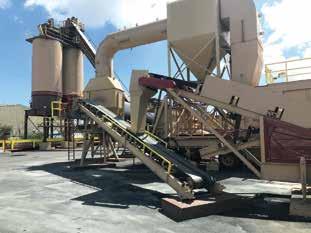
We are here to assist in helping you sell your used asphalt plant equipment for the best price on the market. In addition, sometimes a used component can solve your issue as well as a new one for a much lower price. We will advise you on the best option for your particular situation.


The project site was about an hour from the asphalt plant, so accurately accounting for asphalt absorption during the mix development phase was critical to ensuring the volumetrics of the mix met the project-specific requirements.

The project scope included the full removal and reconstruction of the outer 24 feet on each side of the runway, while the center 60 feet in width was slated for an asphalt overlay. However, this central portion exhibited extensive surface cracking that required proper repair to ensure a stable and long-lasting finish.

Longitudinal joints were carefully constructed after cutting back the existing pavement edge to promote strong bonding, with joint surfaces thoroughly cleaned and tack coated before placing new asphalt. The completed project’s PRI showed a significant improvement of 57% to 90%, reflecting the collaborative efforts of the paving and quality control teams in overcoming tough conditions to deliver a high-quality runway.
was developed, leading to a few weeks of paving delays. Adding to the complexity, the asphalt plant in Waimea was scheduled to be relocated around the same time for another paving project. To maintain progress, a new mix design was developed using aggregates from a different source for the asphalt plant located in Hilo, located on the east side of the Island. After a careful review by USACE’s TSC, the new mix received the green light, and paving quickly resumed with minimal disruption.
Although not required by the project specifications, the proposed mix designs were also verified for optimum asphalt content using a simple analytical procedure published in the ASTM’s Journal of Testing and Evaluation, titled “Simple Analytical Procedure to Estimate Optimum Asphalt Content.” This additional verification produced results that closely matched the optimum asphalt content of the proposed mix designs, offering further validation and confidence in the final design asphalt content and the procedure.
The project site, situated at approximately 6,000 feet above sea level between two mountains, presented the working crew with unique challenges—including scorching heat and persistent gusty winds. These winds were intensified by the valley’s geography, which seems to act like a natural wind tunnel, accelerating airflow between the two mountain peaks. This not only complicated paving but also created mix cooling challenges. Despite the roughly one-hour hauling distance from the plant, the hauling of mix was well managed throughout. Mix temperatures stayed mostly within the target range, with only a few minor exceptions. Paving was done in 18-foot-wide passes at variable depths, mostly between 2 and 3 inches, using a standard rolling sequence of breakdown, intermediate, and finish rollers to ensure proper compaction. Longitudinal joints were carefully constructed after cutting back the existing pavement edge to promote strong bonding, with joint surfaces thoroughly cleaned and tack coated before placing new asphalt.
The paving crew, aware of the field conditions and the stringent specification requirements, approached and executed the paving operation to meet the project’s demanding standards. The quality control department provided critical support in continuously monitoring mat and joint densities. Cores drilled for thickness and density testing met specifications. Final profiling after paving revealed some areas needing grinding, and the quality control department worked closely with the grinding crew to address all must-grind bumps. The PRI showed a significant improvement of 57% to 90%, reflecting the collaborative efforts of the paving and quality control teams in overcoming tough conditions to deliver a high-quality runway.
Despite a few minor hurdles along the way—ranging from material adjustments to environmental and logistical challenges—the success of the runway rehabilitation at Bradshaw Army Airfield was a direct result of strong communication and coordination between EPC and JWG. While each team operated within its scope of responsibilities, it was our shared commitment to quality, problem-solving, and teamwork that ensured the project stayed on track.
The end result is a significantly improved runway that meets rigorous military standards and is ready to support the ongoing mission at the PTA for years to come. To mark the completion of this important effort, a ground blessing ceremony for the newly rehabilitated runway was held on Sept. 23, 2025, honoring local tradition and as a gesture of respect for the land.
Since its introduction, the Weiler P385 has set the standard for commercial pavers. The P385C raises that standard.
Increase to 120 hp with the Cat® C3.6 Tier 4F/Stage V engine.

Variable speed and reversible conveyors and augers and a 25% increase in tunnel height provide optimal material output.
Modular conveyor drive and sealed chain case increase feeder system reliability and life.
Enhanced heat system performance with direct-drive hydraulic generator and elimination of GFCI breakers.

BY JORDAN FONTAINE
Founded in 2008 and spearheaded by President John Collins, Sustainable Pavement Technologies (SPT) has grown to become a leader in providing sustainable solutions for the heavy highway industry. The company focuses on asphalt pavement, roofing shingle material and concrete demolition recycling while operating out of five key sites in Texas, in major cities like Dallas, Fort Worth, Austin, San Antonio, and Houston as well as two additional sites in California. With a dedicated team and a mobile fleet of crushing, grinding and screening equipment, SPT consistently delivers for its clients.
The reclaimed material that SPT receives is processed and repurposed to create high-quality aggregates for use in hot-mix asphalt (HMA), ready-mix concrete and road base. As a recycled product, this material boasts a lower CO2 output than virgin material, as much of the environmental impact is incurred on its initial creation. This is further enhanced by SPT’s choice of diesel-electric driven crushing and screening equipment—the Gladiator range from Powerscreen Texas.
“The Gladiator is a great addition to our fleet for many reasons, including its versatility,” Collins said. “Having the ability to move our Powerscreen Gladiator 320SR to any one of our sites and be up and running within 24 hours has been a game-changer for us.”
SPT’s mobile production capabilities allow the company to handle various commercial projects and State Department of Transportation contracts, ensuring that materials are sized according to strict specifications. Whether it’s handling demolition debris from a construction site or reprocessing broken road surface material, SPT’s
Powerscreen equipment can transform waste into high-quality aggregates that contribute to new infrastructure projects across Texas.
The success of SPT has been supported by its long-standing partnership with Powerscreen Texas since 2016. The relationship between SPT and Powerscreen Texas began when Collins purchased a Terex Ecotec Phoenix 2100 trommel at an auction. Soon after putting the trommel to use, the machine ran into an engine failure. However, Powerscreen Texas quickly stepped in to help.
“I called Powerscreen Texas, and within a few days, they brought out a new engine and installed it for us,” Collins recalled. “Within the next year after using our newly fixed Phoenix 2100, we expanded our fleet of machines from Powerscreen Texas and have purchased a machine from them each year since.”
Today, SPT operates several pieces of Powerscreen equipment, including the Powerscreen Gladiator 320SR, Trakpactor 320, Chieftain 1700, Chieftain 2100 and the Terex Ecotec Phoenix 2100 trommel. This robust lineup of machinery allows SPT to handle large volumes of recycled material with efficiency and ease.
According to Collins, the Powerscreen Gladiator 320SR has been a valuable asset to the company. This diesel-electric hybrid unit is capable of processing 2,000 tons of material per day, consistently meeting SPT’s production targets while maintaining fuel efficiency.
“We achieve a considerable uptime with the Gladiator...” Collins said. “It’s a diesel over electric unit, so it gives a really steady and low fuel burn along with a very consistent output.”






The reclaimed material that SPT receives is processed and repurposed to create high-quality aggregates for use in hot-mix asphalt (HMA), readymix concrete and road base. As a recycled product, this material boasts a lower CO2 output than virgin material.


At SPT’s Fort Worth site alone, the company produces between 350,000 and 500,000 tons of recycled asphalt and concrete annually. These materials are processed into various gradations, depending on the specific requirements of each project. The recycled aggregates are then sold to commercial material producers or used in State DOT projects that demand precise material sizing for stringent specifications.
In addition to their work at fixed sites, SPT also takes on a wide range of contract work across Texas. With mobile crushing, grinding and screening spreads, the company can deploy its fleet of Powerscreen machines to any site, providing on-demand solutions for contractors and subcontractors in need of reclaimed aggregate materials.
Collins is proud of the company’s ability to adapt to different project requirements and environments. “We’ve worked in various quarries, recycling shot rock and other materials. No matter what kind of project comes our way, we can provide a solution thanks to Powerscreen.”
As the demand for sustainable construction materials continues to grow, SPT remains at the forefront of asphalt recycling innovation. Their commitment to quality, sustainability and customer service has made them one of the most trusted names in the Texas recycling industry.
“Our relationship with Powerscreen Texas has been a crucial part of our success,” Collins said. “We’ve had great support from their team, and we’re continuing to grow that relationship as we identify what our customers demand and what machines will better elevate our business to better serve the State of Texas.”
Looking ahead, SPT plans to expand its operations even further, ensuring that they continue to provide high-quality recycled materials for the construction industry. With more than 15 years of experience, the company is well-positioned to remain a leader in sustainable pavement solutions, helping to build a greener future for Texas and beyond.

BY SANDY LENDER
During the spring 2025 paving conference of the Maryland Asphalt Association (MAA) in March and again during an April 2025 lunch and learn event, the Maryland Women of Asphalt (MD WofA) branch introduced a new program called Paving & Pastries (P&P). The program officially kicked off with its first event, hosted at the Allan Myers Inc., Fallston office on May 13, with a second event in July at M Luis Construction Co., headquartered in Curtis Bay, Maryland.
The branch doesn’t yet have an outreach committee, so efforts like the P&P initiative help connect women across MAA’s member companies, offering more women, who might not otherwise have the chance, to learn of the MD WofA mission.
“While we do have numerous events throughout the year, we are not able to touch everyone with these events,” Chairwoman Amy Eckert explained. When it comes to connecting with the ladies when they’re in the field, timing can be difficult. Instead, the branch can set up a P&P visit at the member company’s site when it’s most convenient for workers. “When we are coordinating these events, we do them at whatever time is most beneficial to accommodate everyone’s schedule. We hold them at whatever location works best for that company. Some of our members have different facilities from their corporate office to their asphalt plants so we let them determine what space works best for them and we hold it there.”
After the MAA paving conference and lunch and learn event in the spring, women from Allan Myers and M Luis reached out to participate in the new initiative. Eckert coordinated the dates and times that worked for the companies and members of the MD WofA council who could join in. “It is a team effort,” Eckert explained. “But I generally am the main point person, coordinator with the company,

Amy Eckert gave a presentation during the first Paving & Pastries visit. She shared that having a warm welcome from the ladies at Allan Myers and getting to meet so many of their female team members made the event a memorable success for her. “We had a great turn out. I was nervous since it was the first one that we had done. I had gone over everything that I wanted say in my head but it’s a lot different when you are now in a room full of people but the team was so nice and engaging that it made my nerves simmer down and allowed a lot of connections to be made and great conversations.”
and do the majority of the presentation during the event.”
The events include more than a presentation from the WofA branch—they offer networking and community.
“We bring doughnuts, coffee and water for the ladies to enjoy,” Eckert shared. “We start out introducing ourselves, who we are with MD WofA as well as what our actual job is, how long we have been in the industry and a little bit of our journey. We then go around the room and have all of the ladies that are in attendance introduce themselves. I then tell them all about WofA as a whole, how we got started nationally, what our mission is, the current standings regarding all of the branches we have now and when our branch got started. From there it’s explaining all of the events that we do, what is in the works for our branch, and I open it up to any questions or comments that anyone has. We are still growing as a branch and it’s important to be beneficial to our mem-
bers so we value the opportunity to hear the thoughts and ideas that the ladies have to see if we can adapt and continue to grow.”
As part of the morning event, there are, of course, pastries.
“The first one that we did with Allan Myers was at 6 a.m. so that we could meet with the ladies before they had to get their day started. Which is also where the pastries come in. It’s always good to have some breakfast before they get their days started.”
Eckert also spoke of the inclusivity of the visits.
“It’s important to be able to connect with every woman that we can no matter their position or their length of time in the industry so they know that we exist, we welcome anyone to join us and are a valuable resource to help empowering women in the asphalt industry by mentorship, education and networking.”
The MD WofA come bearing gifts as well as encouragement.



and

“Another thing that we do for these events is give all of the ladies Potty Packs. We had zipper pouches made with our logo on it, and we filled them with necessities that women need when using the restroom. For the ladies in the field a lot of them rely on using a porta potty, which can be very hit or miss with the conditions of it. So in these bags we put packs of tissues (not enough room to fit rolls of toilet paper so this was the next best option), hand sanitizer, tampons and individually wrapped on the go flushable wipes so that they can carry these packs with them at all times and when they need to use the bathroom they can just grab them and take them with them so they have all that they need and not have to worry about going into a porta potty that might be out of toilet paper or hand sanitizer.”
Some of this may sound similar to the South Carolina WofA’s Building Community with Biscuits program outlined in the July issue, and there’s a reason for that. The WofA share ideas to help branches grow.
“Our past chairwoman, Stefani Martella, is a board officer for the WofA National and she had heard what South Carolina did and brought the idea to us so we could adapt our version of it in Maryland. I am the current chairwoman, so I have become more of the leader when it comes to speaking engagements and it’s something that I am passionate about, so it’s been easy to help lead this initiative when your heart is behind it.”
Others have seen the value and passion behind the project as well. Andrea Imhoff with M Luis is the woman who reached out to host a visit at the company.
Their daughters,
and Natalia Luis, now own and run the company. Natalia picked up her parents, so they were able to join everyone for the P&P event. “As a female owned company, they are very supportive of our mission,” Eckert shared.
“I was passionate about organizing the Paving & Pastries event for the ladies of M Luis to introduce them to the valuable resources available through the Maryland Women of Asphalt. It’s important to me that our female employees feel supported, empowered and equipped with opportunities for both personal and professional growth within our industry.
“In a traditionally male-dominated industry, having an organization like Maryland Women of Asphalt is truly invaluable,” Imhoff continued. “It offers a safe space for women to connect, ask questions, share experiences, learn and give back to the community—something that is essential for building confidence and long-term success!”
And that success is open to anyone who wants to attend. Eckert explained that any female that is employed by the company is welcome to attend a P&P event. “Executives, office personnel, drivers, ladies that work in the field or at the asphalt plant, it does not matter to us what their position is, our mission is to be able to connect with as many ladies as possible.”
So far, that mission of connection is off to a great start with the MD WofA P&P initiative. Any companies in Maryland that wish to participate can reach out to Eckert and other WofA branches who are interested in a similar program have two shining examples to follow.





Silo cone opening is 36” wide for ef cient material ow.

Safety gates on all silos, including long-term and standard options.

Recessed tub liners prevent silo wall wear, avoiding bulging issues.

Silo bin top batchers feature secure long-term seals.

Recessed wireways on silo tops eliminate trip hazards.



Meeker drag conveyors are larger, allowing slower chain speed and reduced wear.

Hydraulic chain adjustment on slats maintains asphalt entry point, minimizing wear.

Visual chain tension indicators on Meeker slat conveyors aid operators.

All silos prewired with top and bottom junction boxes.





All Roads Construction expands its Vancouver asphalt plant capacity without missing a shift— balancing growth, environmental performance, and nonstop customer service.
BY SARAH REDOHL
WWhen All Roads Construction opened its asphalt plant in Vancouver, British Columbia, in 2020, it set a new local standard for efficiency and environmental performance. Now, after a major upgrade completed in spring 2025, the company has increased its storage capacity by almost 70% while maintaining full production and the same cleanair results that defined the original facility.
All Roads President and CEO Rod Stephens said the decision to expand was about staying ahead of demand while protecting what made the plant successful from the start. “We wanted to grow our capacity without losing the reliability and environmental integrity we built this operation on,” he said.
The project reflects both market growth and All Roads’ long-term strategy: to meet higher material demands, adapt to new mix specifications, and keep the doors open to third-party customers 24/7. From planning through installation, the expansion showcases how careful coordination, in-house expertise, and a focus on service can turn a logistical challenge into another example of continuous improvement.
When All Roads Construction decided to expand its Vancouver asphalt plant, the move was driven by production realities, not speculation. “We have about 400,000 tons of Highway 1 Trans-

Canada paving to do,” Stephens said. “And over the last five years, our third-party sales have skyrocketed.”
The dual demand of major infrastructure work combined with strong third-party growth put pressure on the plant’s capacity and flexibility. “Not only were we coming up short on volume, but we also needed capacity for a broader variety of mix designs,” said All Roads Plant Manager Dennis Eby.
That last point became even more important when government specifications changed to require polymer-modified asphalt in toplift paving. The new spec meant the plant needed additional binder storage and more room to handle multiple AC products without disruption. As Stephens later explained, those evolving requirements were a key driver behind adding both new silos and a larger binder tank—ensuring All Roads could meet every mix design its customers demanded.
With more work ahead and more contractors relying on them, All Roads needed a way to produce multiple mixes at once while maintaining the customer service that helped drive that growth. “We run three plant crews so that we can run 24 hours a day and seven days a week,” Stephens said, adding that the company’s round-the-clock availability and commitment to customer service have been key to building customer loyalty.
Despite All Roads’ need to expand, they didn’t want the customer service so responsible for their growth to suffer. They needed to figure out how to expand production capacity while keeping the plant fully operational—and just as clean and efficient as the day it opened.
Expanding a continuously running asphalt plant required both precision and restraint. All Roads’ goal was clear: stay open, stay safe and finish on schedule.
“We started the planning process in November when we met with Gencor,” Eby said, adding that they began the upgrades the following


January. “Our goal from the beginning was to keep the plant open full time and accessible while these improvements happened.”
The project added two 200-ton silos and a 45,000-gallon AC binder tank, supported by 20 piles to make the new structures earthquake-resistant. “There was a lot of groundwork involved initially,” Eby said. “And that all happened simultaneously while we produced asphalt.”
Every bit of work from excavation to setup was handled by All Roads’ own crews, without a single injury or incident.
“During construction, we made minor tweaks in the yard to ensure that our customers could be loaded in conjunction with our crews,” said All Roads COO Mike Darby, who led the on-site construction work. “This included having internal and third-party sales truck lines and yard coordinators during busy times. We determined in advance that we wanted our customers to be impacted the least and typically sacrificed our own crew productions to accommodate this service orientated goal.”
Construction wrapped up just in time for the 2025 paving season. “This is the year of fives for our asphalt plant. It’s now five years in the making, with a recent upgrade to five storage silos, in the year of 2025,” Darby said. Eby added, “The tank came online first in the middle of May, and then the silos were up just in time for our busy season.”
A key decision early in the project ensured the plant would be ready for that surge. “I was originally just going to order one silo, not two,” Stephens recalled. “But Dennis just phoned me one day and challenged me, ‘Why are you wasting time? Let’s just get both going right now.’ And I accepted that challenge.” The choice to complete the full expansion at once proved essential to meeting production targets.
Unpredictable tariffs briefly complicated equipment delivery. “We ended up by getting two of our silos through with no tariff,” Stephens said. “And then when our AC tank came through a week later, they hit us with a $75,000 tariff.”
Even with that setback, the team refused to cut corners. “We wouldn’t have sacrificed the sustainability performance of our tank for the sake of the $75,000,” Stephens said. “We wanted the product to be consistent with everything else we have.”
When the final pieces came online, All Roads had gained almost 70% more storage capacity without interrupting production—a rare feat for any continuous-run facility.
With the new infrastructure in place, the focus turned to performance: how the upgraded systems improved efficiency, environmental control, and the plant’s already-strong emissions record.
When the upgraded systems came online, the impact was immediate. All Roads produced more than 400,000 tons of mix in 2025—about 15% more than the previous year—without increasing emissions or energy use.
The new silos and binder tank have streamlined production and reduced downtime between mix changes, allowing operators to keep materials hot, organized, and ready for dispatch around the clock.
“The additional silos also allowed us to fill orders for the day shift immediately after the night shift projects were complete,” Darby said. “This gave us more room to better service our day shift projects and our smaller third-party customers.”


























































































All Roads Construction’s Vancouver asphalt plant stands complete after its 2025 expansion, featuring five 200-ton storage silos and a new 45,000-gallon AC binder tank.
Stephens said the improvements also prepared the company for the province’s evolving binder requirements. “Now, nothing can stop us,” Stephens said. “There’s no mix we can’t make.”
Just as importantly, the expansion preserved the plant’s environmental performance—a cornerstone of All Roads’ identity. The company, which describes its facility as the greenest asphalt plant in Canada, continues to post its emissions data publicly. “Our particulate is not even a tenth of what we’re allowed to be able to produce,” Stephens said. “We blow the specs right out of the water and we’re proud of that, so proud we post those results online.”
That strong environmental record also made the permitting required for the expansion easier. “The [city] could do quick calculations to determine that with this upgrade we’re still way below permitted levels,” Stephens said.
Performance gains have come not only from technology, but also from experience. “It’s almost like our plant is getting greener and cleaner,” Stephens said. “Part of that is because our guys are actually learning the plant better… and it makes it burn more efficiently, which means we emit less.”
Five years after commissioning, the Vancouver plant continues to perform cleaner and more efficiently than when it was first built—a testament to both its design and the team operating it.
That same team—the operators, maintenance staff, and managers who keep the facility running 24/7—remains central to All Roads’ success and to sustaining those performance gains.
Behind All Roads Construction’s around-the-clock operation is a team that keeps the plant running smoothly, safely, and continuously improving.
“We don’t wait until the winter months to perform all our maintenance,” Eby said. “We’re constantly repairing and upgrading, and improving on the fly.”
All Roads Plant Superintendent Jordan Shepell skillfully lays out all maintenance projects in advance. “If we get a rain day or a couple hours, they know how long that maintenance task is going to take and they hammer it out fast.”
That responsiveness proved essential during the expansion and remains part of daily life at the Vancouver plant. Tight coordination between loadout crews and truck drivers ensures the site runs like clockwork even at peak capacity. Stephens credited the on-theground teamwork that allows materials and traffic to flow safely through a compact site without delay.
Investing in training has also strengthened the operation. Each year, All Roads sends plant personnel to Gencor’s training facility in Florida to sharpen their technical skills and deepen their understanding of the system. “They actually light a burner and show the guys there what a perfect flame is,” Stephens said. “The guys get so much out of that training. They get to understand the drum’s internal flighting system and all the plant’s major operating components.”
That emphasis on development has given All Roads more bench strength than most single-plant operations. “We have five plant operators,” Stephens said, “whereas most competitors can hardly find one.”
Stephens said a culture where learning, teamwork, and respect are daily values makes the company a sought-after workplace. “When you have people reaching out to you to want to come to work for you, instead of you trying to find these people, that’s a huge advantage.”
That sense of pride and camaraderie runs deep. As Stephens put it, “We’re here to have a lot of fun and hopefully make a little bit of money.”
Five years after opening what the company calls the greenest asphalt plant in Canada, All Roads Construction continues to prove that clean operation and high production can go hand in hand.
Looking ahead, All Roads plans to document its environmental performance even more formally. “We don’t have [an Environmental Product Declaration] yet, but it’s on my hit list to be able to achieve in 2026.”
For Stephens, that next step is part of the same philosophy that guided the expansion—continuous improvement, backed by investment in people and technology.
“Asphalt plants are necessary to service the industry and the roads we travel on,” he said. “At All Roads, we’re going to continue to do that in the greenest way possible.”



Achieve precise paving when everyone has what they need, safely at their fingertips
BY SANDY LENDER
IIn the November issue, we looked at a variety of ways to augment the paver delivered from the dealership or auction house, so it might offer its most efficient environment for the paving crew when handling, storing and using auxiliary equipment. Crew members need a safe, uncluttered workspace where they can access an increasing number of tools and tablets during the shift. Let’s take the discussion a step further this month with a deeper dive into safety and trucking, starting with a patent-pending design from N.B. West Contracting Co., Pacific, Missouri.
The National Asphalt Pavement Association (NAPA), Greenbelt, Maryland, awarded N.B. West the 2024 Asphalt Operations Safety Innovations Award during a ceremony at the association’s 70th annual meeting, for its protective guards for paver operators. While original equipment manufacturer (OEM) standard guards protect operators in fixed positions, N.B. West’s custom-fabricated guards, welded to the operator’s seat frame, provide protection regardless of seat position. Since the first installation in May 2024, the company had reported zero incidents or near-misses and, as of press time, had received approval to move forward in the patenting process.
NAPA stated in a press release, this worker safety initiative fills a void in commercially available paving equipment protection and offers a replicable solution for other paving companies. N.B. West Safety Director Tim Swaringam confirmed this concept, stating all seven of the company’s pavers, which include various makes and models, had the safety cages installed as of November 2024.
Logistics Manager Noah DeRousse and Shop Manager Nick Brewer worked with Swaringam on the company’s safety committee and helped design and build the protective guards.
Before he took on the role of logistics manager, DeRousse spent six months working directly with Swaringam in the safety department as the field safety coordinator. “During that six-month period, we really worked on these cages and tried to improve the safety of our operators here at N.B. West,” DeRousse said. “Prior to the six months in the safety department, I ran one of these machines...for 21 years. I’ve seen a lot of incidents happen over the years, a lot of operators injured, a lot of really close calls.”
Brewer explained that his team in the shop helped design and install the safety cages. He shared that whenever the paver operator’s seat is positioned right along the inside of the confines of the paving machine, there’s protection for the operator with the OEM’s platform structure. This position is typically used when transporting the machine.
“This is more for transportation of the machine out on the highways to and from the job sites,” DeRousse shared. “If I’m sitting here and my asphalt hopper is lifted up...I can see just fine.” If the hopper wings are down for paving, “you can’t see your line. You can’t see
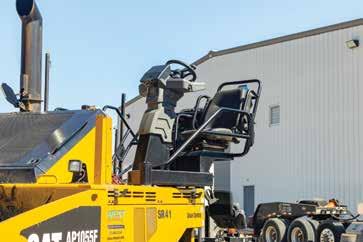
For N.B. West Contracting Co., Pacific, Missouri, it was a team effort to design and build the safety cages to protect paver operators from struck-bys. The final result garnered them the 2024 Asphalt Operations Safety Innovations Award from the National Asphalt Pavement Association. Photo courtesy of N.B. West
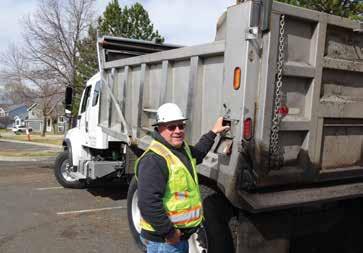

To help the paving crew when doing handwork, Dwight Michael of Michael Trucking, Ft. Collins, Colorado, installed a covered switch at the back of the haul truck. Now, from outside the cab, he can toggle the switches to hydraulically raise and lower the truck bed. The round button above the two switches turns the hydraulics on. Photos courtesy of John Ball, Top Quality Paving & Training, Manchester, New Hampshire
where you’re trying to pave. So, you end up kicking this seat out the second or third click. Once you kick it out where you can see down the hopper, then you’re exposed out here if you don’t have a safety cage. Over all my years of running an asphalt paver, I was hit several times—one time causing some nerve damage in my elbow that never has gone away. And every operator that I’ve known that’s been a paver operator for any substantial amount of time has been hit or had a really close call. I would say over my 20-year career, probably 15 times I had trucks hit the back of my seat. Not all of them have hit me, but it would only take one to be a really big injury for someone.”
The safety cage design includes signage to alert drivers that the seat has been kicked out from the confines of the operator platform. Swaringam and Brewer spoke of adding the slow-moving vehicle triangle to the back of the operator’s seat.
When the operator moves the seat “out” to get a better view for paving, his upper torso is exposed. “The only thing protecting him is the back of that seat, which doesn’t really provide any protection at all,” Swaringam said. “Anything that hits that seat could possibly harm the operator. At nighttime whenever there’s low visibility, you can see there’s nothing on the back of that seat to visually see the operator sitting out there. The only thing is [the operator’s] Class 3 vest, but that’s really all that a passing motorist would see is his sleeve sitting there.”
The team began problem-solving by considering administrative controls—such as how to adjust truck driver behavior. But a truck pattern can’t always be perfected in a tight work zone, and passing motorist behavior is an uncontrollable variable. The next step was engineering controls—that’s where the safety cages began. The last step

This crew has affixed an 18- by 24-inch box on the back of the paver to store pavement marking paint, headsets, measuring tape, release agent spray and other smaller items you don’t want to trip over or lose track of at the side of the project. The box can include a lock to protect the expensive items like headsets or sensors overnight. Photo courtesy of Ball
is personnel protective equipment (PPE), but the team focused on an engineered solution.
“That safety cage provides a lot of protection for the upper torso, the neck and back and head area, the sides. Whenever Nick designed this, he designed it where the side flanges actually will deflect anything away from the operator, not allow it to come in.”

Any source of heat that requires a burner — including natural gas, propane, diesel, or fuel oil — also exhausts emissions into the air.
Replace your tank heaters, hot oil heaters, fuel oil preheaters, and distributor truck heaters with our zero-emission, 100% efficient, Lo-Density® drywell-style electric heat. Sustainable PHCo heaters not only operate without combustion or emissions, they also eliminate a source of fuel spills. Find out more:
866-682-1582 info@processheating.com www.processheating.com

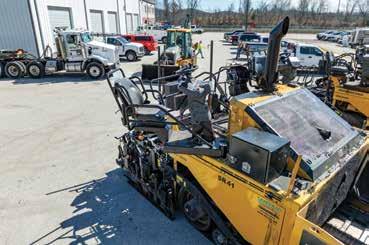
Another aspect of N.B. West’s award-winning safety cage design was to add the slow-moving vehicle triangle as a visual safety factor to the back of the operator’s “seat.” RIGHT: As of November 2024, all seven of N.B. West’s pavers had the safety cages installed. Now paver operators have added protection against struck-bys when they need to position seats for improved visibility. Photos courtesy of N.B. West
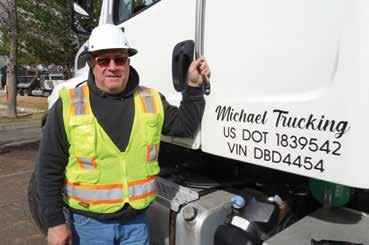

“It was kind of a different aspect for me,” Brewer said. He shared that oftentimes, when different department heads approach the fabrication shop to make equipment modifications, the purpose is to increase production or functionality. This was one of the few times he’d been involved in a project with the sole purpose of increasing safety for the operator. “So, it was a little bit of a different kind of scope, but I wanted to design something that gave the operator a lot of protection, but didn’t disrupt the communication between him and the screed or anybody else working behind the paver or any trucks while using the paving machine. So, it started as just a simple sketch. I went around and took measurements because we own several different models and several different brands of machines. I wanted [the cages] to be somewhat universal, easy to install, and provide the protection needed...It seems to provide a lot of protection for the operator with no downfall of communication visually or verbally.
“Another aspect of the design was to add a visual safety factor as a slow-moving vehicle triangle to the back of the operator’s protection.”
The award committee for NAPA helped N.B. West create a video announcing their achievement in which Swaringam said, “It really helped propel our safety culture to a more collaborative safety culture where everyone wants to be involved in making safety innovations
and looking at ways that we can improve our safety out in the field, for our workers that are working out there every day.”
Not only the collaborative nature of the project, but the winning of an award for the effort has brought renewed energy to the safety culture.
“This really brought a lot of energy to our field workers to be bringing up safety innovative ideas to us...we’re all a team, we’re all trying to achieve the same goal, and that’s to make sure that the employees working out in the field make it home safely to their families every night.”
Dwight Michael of Michael Trucking, Ft. Collins, Colorado, has taken safety and efficiency a step further by installing a camera atop his haul truck cab and directing its feed to a screen above his driver’s seat. This helps with safety because, from inside the cab, he can monitor what’s happening in the truck bed. The camera lens is protected by a steel-mesh screen bolted around the camera’s housing.
When sharing mix delivery and loadout articles, AsphaltPro Magazine reminds haul truck drivers to stay inside the safety of the haul truck cab at all times. We’ve stressed the importance of building systems at the asphalt plant and cleanout areas near the work zone to enable drivers to do all the stages of their jobs without having to wander around dangerous areas. Keep in mind, there are exceptions to every rule.

Michael is an entrepreneur who has devised a way to safely and efficiently help the paving crew that performs extensive handwork. In this case, he has built a hydraulic control at the back of his truck for lifting and lowering the bed when he’s outside the cab.
The control is housed in a protected box on the side of the truck. Inside is a button to turn on/off the hydraulics and two toggle switches to raise or lower the truck bed. In the image on page 36, you can see the chute in the center of the tailgate, which will feed material to the wheelbarrow as Michael gently lifts the bed with the toggle switch. You can also see in that image that Michael has parked the truck on a solid, level surface for this work.
Because he has built this hydraulic system and can control it from this safe vantage point, he can watch and control the material flow without running back and forth from the cab to start the truck, raise the bed, etc. He has made the operation more efficient for the laydown crew he works with as well as himself.
Photos courtesy of
Top Quality Paving & Training, Manchester, New Hampshire


As we saw in the November issue and here, many crews in the field devise those extra systems and clever contraptions to give equipment in the work zone that additional edge when it comes to safety and efficiency. Tell us about the unique device or setup your crew has built to make the job easier, faster or safer. You can share on our social media channels or send an email to our editor, sandy@theasphaltpro.com.
WEB EXTRA: Watch a video from N.B. West Contracting on the creation of the safety cages at the company’s YouTube channel here: https://youtu.be/LBGkKoThqlE?si=l6oVS_HbnA67HCVd

BY SANDY LENDER

From left, Preferred Materials team members Seth Metz (plant manager) and Anthony Marcucci (area manager) discuss the day’s productivity next to one of the recycle piles that makes high-RAP mixes possible.
AAs CRH’s footprint has grown in the United States, the operating companies in its portfolio have brought a wealth of ideas and innovations to the multinational group. The team from Florida highlighted herein has added a host of quality paving awards alongside its contributions. President of CRH’s Americas Materials business, Jason Jackson, sat down with AsphaltPro to discuss Preferred Materials Inc., A CRH Company, Tampa, and the overall progress award-winning projects help bring to light.
From Aug. 4, 2022, to July 21, 2023, the Preferred Materials team handled a range of technical and logistical challenges to repave the Dale Mabry Highway (State Road 597) in Tampa. The resurfacing of the busy urban corridor handling traffic to and from Tampa International Airport demanded coordination with MacDill Air Force Base, the Raymond James Stadium® ongoing event schedule, a dense net-
work of local businesses, as well as the Florida Department of Transportation (FDOT). In the end, Preferred Materials achieved an average International Roughness Index (IRI) of 32 on this project and was awarded the 2024 A.P. Bolton Award and Florida’s Smoothest Pavement Award from the Asphalt Contractors Association of Florida, and FDOT’s 2023 Best in Construction Award.
Let’s examine the Dale Mabry project and the mindset that brings innovation and excellence to individual CRH companies.
One of the ways CRH is innovating for the future is through leveraging digital technology, which the company sees as a key enabler of enhancing the way it does business and delivers for customers. This includes the exploration and adoption of Artificial Intelligence (AI).
Within its Americas Materials business alone, CRH has 1,660 locations and about 29,000 employees. CRH is comprised of hundreds of established local operating companies. Notable brands include MidSouth Aggregates, Preferred Materials, Tilcon, Mulzer Crushed Stone, Texas Materials, Staker Parson, Dufferin Construction, Callanan Industries and Bodean. According to the company’s 2024 Annual Report, CRH’s Americas Materials Solutions business reported $16bn in revenue in 2024, achieved an adjusted EBITDA of $3.7bn, up 22% year-over-year, with an adjusted EBITDA margin of 23.2%.

“We are only scratching the surface when we talk about circularity,” President of CRH’s Americas Materials business, Jason Jackson said. “We can’t emphasize circularity enough through the broader construction value chain and specifically in and around roadway design and asphalt.”
“When we look at AI or we look at technology and innovation, we do that with an enterprise lens,” Jackson said. “When we think about innovation, it’s important that we leverage our scale.”
He listed asphalt, aggregates, ready mixed concrete, below-grade infrastructure solutions, water management and other elements of the construction industry where piloting AI technologies offer exciting options. The size and scale of the company means it’s well positioned to explore AI’s benefits.
“CRH has been in this space in roads, in water, in aggregates and cementitious materials for many decades,” Jackson said. “We have a massive amount of expertise and data and so the big question that we challenge our teams and ourselves with is how do we take all that expertise that may exist in thousands of locations and leverage technology as a whole? Or, more specifically, how do we push the envelope to drive improvements utilizing technology?”
One of the areas where the company is leveraging that depth of knowledge is in mix design. “We’ve got a few things going on that are very exciting,” Jackson said. “Number one is around mix optimization.”
With the decades of experience and thousands of locations, Jackson believes CRH stands out for the company’s ability to deliver both performance and quality through its approach to materials science. “This includes creating new attributes for products and materials that have been in place for many years. So, it’s about evolution, which is something we take very seriously in and around materials science.
“When we bring new businesses in, we’re consistently learning from folks that join our


company through acquisition,” he continued. “We want to leverage what they’re working on, what their knowledge base is and when we combine that at scale, we have the opportunity to do wonderful things in and around materials science.
“We make sure to bring these teams together to really reimagine the art of the possible. When you think about new mixes— and that goes for asphalt mixes in particular—we’ve probably made the most significant strides in those areas by bringing those experienced, localized teams together to leverage high levels of technical knowledge.”
One of the ways CRH is optimizing mix design is by focusing on next-generation surfaces to stand up to extreme temperatures, heavy traffic weights and erosion. “We design specialty asphalt mixes that help extend the lifespan of the road, reduce its maintenance costs, improve its strength and resilience, and reduce traffic noise, which reduces its impact on the environment,” Jackson shared. Examples include:
• Super Sand Mix (SSM), which is a custom blend incorporating RAP, infused fibers, waste sand and used tire rubber;
• A low-carbon, high-percentage RAP asphalt mix used on the Dale Mabry highway project;
• Self-healing asphalt or warm-mix asphalt, which is engineered to repair cracks automatically.
Self-healing asphalt trials are still in early stages of maturity across the United States. The company is routinely using bio-based rejuvenators to improve asphalt mixture flexibility, which provides for a more durable, long-lasting pavement.
“Additionally, we are innovating with fibers (synthetic and natural) to distribute stress more evenly throughout the asphalt mix, helping to reduce fatigue cracking under heavy traffic loads. For example, Texas Materials, A CRH Company, has successfully pioneered the first large-scale use of an asphalt mix we call Super Sand Mix (SSM) in the city of Fort Worth. It’s an innovative, highly durable, fiberreinforced asphalt, specially formulated to enhance the surface texture of city streets and rural country roads. With proper maintenance, SSM is expected to achieve double the lifespan of a traditional asphalt product.”

It’s not only CRH operating companies innovating, as Jackson mentions above. The company welcomes and encourages outside collaboration for problem-solving too.
“When you think CRH, we’re the largest building materials player in the market,” Jackson said. “And while our reach is international, we’re deeply committed to operating at a very local level.”
Consider how climate needs and geography influence state specs. Not only is this the foundation for making our industry’s asphalt mix designs more resilient, but it also gives companies like CRH the opportunity to work on solutions to local challenges.
“Our local folks are very engaged in their local markets,” Jackson said. At the corporate level, CRH can take the connected portfolio of knowledge to prepare solutions “at scale,” but it takes boots on the ground at the local level to know where different solutions are best applied.
“CRH leverages its scale and connectivity to deploy innovation—whether it’s a higher percentage of RAP or innovative mixes with recycled shingles. But importantly, there is no one-size-fits-all approach. We pride ourselves on engaging with local authorities, DOTs and the traveling public to truly understand their challenges and design a solution specific to their needs. Scale is important, but customer connectivity, local knowledge and relationships are paramount.
“It’s really a team approach in problem identification and then we’re developing solutions in partnership with our customers. And I think that’s how you change specifications, that’s how you increase adoption. That’s how we’ve really taken a lot of these new and innovative solutions forward through a partnership approach—starting with the problem statement and then working to a solution.”


That’s why we bring more than just tools, we bring the fire.
From retrofits and relocations to maintenance, parts, and plant upgrades, Motion Engineering keeps your plant running hot and smooth. With over 30 years in the asphalt industry, we’ve seen it all and solved it all.
Let’s talk about how to make your next project faster, cleaner, and more efficient.








“I THINK WE’VE PROBABLY MADE THE MOST SIGNIFICANT STRIDES IN THE AREA OF MIX DESIGN BY BRINGING THOSE EXPERIENCED, LOCALIZED TEAMS TOGETHER TO LEVERAGE HIGH LEVELS OF TECHNICAL KNOWLEDGE TO REIMAGINE THE ART OF THE POSSIBLE.”—JASON JACKSON
Another area of AI implementation important to Jackson is that of safeguarding CRH’s most valuable asset: its workforce.
“The other area we focus on in terms of AI, and it’s important and near and dear to my heart, is the people and safety element,” Jackson shared. “If we think about how we make our locations safer, jobs easier, more efficient and therefore safer, AI is another way we have implemented new measures.”
We see this in action in the trial of smart robotics. One of CRH’s first uses of Spot, the agile mobile robot from Boston Dynamics, Waltham, Massachusetts, was at the Ash Grove Cement Plant in Seattle, Washington. In a year-long pilot, the robodog performed proactive yet repetitive inspection routines. According to CRH, this sophisticated robot can operate in hot and dusty conditions, improving safety and freeing up skilled teams to solve complex issues elsewhere on site.
Jackson went on to say, “Spot helps do inspections at our cementitious plant locations, taking thousands of readings. The bot knows if there’s a motor running too hot or if a there’s a trip hazard or something that’s an upset condition, etc.”
According to CRH, this state-of-the-art machine is capable of navigating treacherous industrial terrain, taking on hazardous tasks, while its human counterparts stay safely at a distance. For example, at Ash Grove Cement, Spot uses laser scanning to take brick measurements inside the kiln, eliminating potential safety incidents among the workforce. In the early stages of the trial, the robot was able to detect a failing bearing in part of the site’s rotating equipment, which might have eventually led to unplanned downtime. This AI technology eliminates unnecessary downtime, decreases manufacturing site costs and drives efficiencies. Meanwhile, the data col-

One of the ways CRH is optimizing mix design is by focusing on next-generation surfaces to stand up to extreme temperatures, heavy traffic weights and erosion. They’re designing specialty asphalt mixes
that help reduce the road’s impact on the environment.
lected can be used to better enhance the overall efficiency of critical assets and maximize their uptime.
If Spot can handle the temperatures at a cement plant, imagine what it can handle at an asphalt plant to assist ground personnel and plant managers in assessing operations.
The implementation of AI for CRH is “taking the data and the expertise that we have over many, many decades of experience to try to optimize and create higher performing mixes and solutions that we can take to our customers to improve a number of things,” Jackson said. “But it’s also leveraging AI to help protect our teams and ensure that we’re producing the highest quality materials.
“I believe there’s a perception by some that our industry is slow to adopt change. I disagree with that. I think we are making improvements across [the construction industry]. This industry is implementing change at a very good pace, and leveraging these new technologies is something we should all be proud of. Whether it’s a bot that can help do inspections and identify issues that may cause safety or quality problems or it’s leveraging data to improve efficiency, we’re taking significant steps across our industry. CRH is positioned very well—having the size and scale—to lead the way in these new innovative ways of thinking.
“The beauty of our connected portfolio allows us to leverage data at varying positions of the construction value chain and when we do that right, we’re able to help solve our customers’ and our customers’ customers’ most pressing challenges.”
For the Dale Mabry project success story shared herein, FDOT is the customer whose pressing challenge was the resurfacing of a major thoroughfare with numerous businesses, side streets, signalized intersections, median turn lanes, multiple acceleration and deceleration lanes, and high traffic count. The Preferred Materials team stepped up to the task of protecting nesting eagles in the area and businesses along the route with ingenuity, smart equipment choices and the innovative mix design mentioned next.
Preferred’s Tampa plant is an Astec Double Barrel with 500 TPH capacity, located about 15.7 miles from the job. The crew ran three mixes for the project using a significant amount of reclaimed asphalt pavement (RAP) for each:
• A structural course of SP12.5 with 40% RAP and PG52-28
• A surface course of FC12.5 with 20% RAP and PG76-22 polymer-modified
• A surface course of OGFC FC5 with PG76-22 polymer-modified
An anti-strip was added to each binder to help with mix properties and as a compaction aid. They used the oscillation technology of their Sakai rollers in place of traditional vibration. This technique is known to:
• minimize vibrations that would otherwise affect nearby structures and underground utilities;
• reduce disturbance to local wildlife; and
• lower noise levels for surrounding neighborhoods.

The team achieved an average of 92.7% compaction on the structural mix; the friction course mixes were placed in density exception areas (intersections) and did not require density testing.
Jackson also shared his thoughts on the Preferred Materials crew. “This gives me an opportunity to highlight the most important element of CRH, which is our people and our teams. The Dale Mabry project example doesn’t happen without our teams.
“Across CRH, when we look at what we’re able to accomplish, it’s all because of our people. I mean, the project had its own unique challenges, including some of the things they had to contend with—the MacDill Air Force Base that was right there and Tampa International Airport. Don’t forget the Buccaneers. We had Raymond James Stadium right there, and we didn’t shut down during football season or game days. The amount of coordination and our team’s ability to partner with FDOT, who is an amazing customer and partner of ours, is so important to highlight.
“The awards are great, and I know our teams appreciate them and they’re very proud of them. And they should be because the elements of safety, quality, ontime delivery and performance, are hallmarks of what make CRH companies and crews so great. On the front lines, the team leaders and supervisors and the folks in the back office that are making sure everything’s coming together in the right way. I couldn’t be prouder of that team.”
Amid the accolades Preferred Materials received for a job well done, there is also a positive environmental component that should not be overlooked.
“We are only scratching the surface when we talk about circularity,” Jackson said. “We can’t emphasize circularity enough through the broader construction value chain and specifically in and around roadway design and asphalt. I like to look at the roadway as an ecosystem that has a number of parts and pieces that come together to create that finished surface that the people in our communities drive on every single day.
“In 2024, we’ve recycled over 44 million tons of waste and byproduct that has been sourced either internally or from other industries,” Jackson continued. “This makes us the leading recycler in North America. If we think about what we’ve integrated from a recycled asphalt pavement and a recycled asphalt shingle aspect, we’ve used over 13 million tons of
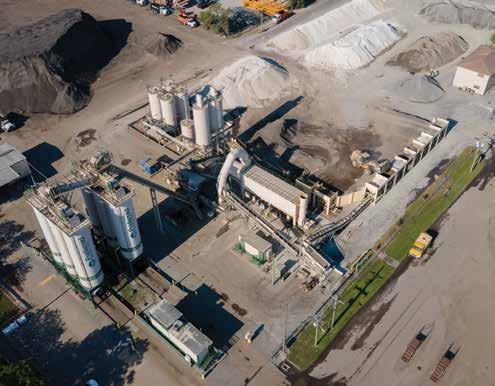

RAP and RAS just in 2024 alone and we are expanding this in 2025.
“Dale Mabry is a great example of how that came together. Not just the results and some of the awards that were won on that project, which are already amazing, but the fact that,
just looking at the circularity element of what went into that roadway. That’s what gets me excited. We’ve built these positions where we are able to lead the way and really reinvent the way we look at circularity in road projects. We can 100% do more with less.”



BY SANDY LENDER
TThe team at Stansteel Hotmix Parts & Service, Louisville, Kentucky, met up with Robert Schedko, a plant operator for Hall Contracting of Kentucky, to assess the performance of a new loadout system. The producer had installed the OEM’s Look, Lock ’n Load technology, and the team wished to check in to share Schedko’s experience with the industry.
Schedko confirmed in an online interview that Hall had the system installed at the end of 2023/beginning of 2024 and, “Since we have used it, we have had zero hood hits and zero spills on the deck for this whole season.”
Let’s look at how that works and what it means for the producer.
A controls engineer for the OEM shared the “Look Lock and Load Safety Loadout Truck Recognition System,” via a smart computer, uses “computer vision” to mathematically use images to train its neural network. When a haul truck pulls up to the silos, the Look, Lock ’n Load system digitally scans an image of the incoming truck and differentiates between the truck’s cab and bed. The display for the plant operator indicates a red zone for the cab and a green zone for the loading bed. More than that, the system can lock out the silo gates in the red zone.
Basically, if you see two green lights on your display screen, you’re ready to load, Schedko shared in his online interview. If


you don’t have two green lights on your display screen, you need to look at your lines and see where errors are happening. He explained that the iteration of Look, Lock ’n Load that Hall had installed locks out all the silos until a truck pulls under the one it’s supposed to load from. Then only the one selected is unlocked; the others remain locked.
“Before the Look, Lock ’n Load, you could dump any time from any silo whether there was a truck on the scales or not,” Schedko said. “It didn’t detect weight. It didn’t detect if there was even anything there that was supposed to be there. This here will actually look out and if it sees a cab of a truck or a person, it shuts it down to where nothing will open. It has to have a truck bed underneath the silo for it to work or another device designed to receive asphalt; not a hood or a cab. This has added a whole new field of safety that we had none of before with our basic loadout system.”
That kind of pressure weighs on the operator who’s monitoring 100+ loads per day along with his other responsibilities.
Lennie Loesch, the president and CEO of Stansteel Hotmix Parts & Service, reminded us, “Human plant operators do not just ‘run machines by pushing buttons.’ They manage dynamic plant systems with moving parts, volatile materials and human factors. Humans watch for unsafe conditions, respond to alerts, coordinate with ground crews and keep an eye on everything using their sight, hearing, smell and their irreplicable human intuition.”
With the management of those dynamic yet repetitive systems comes unintentional complacency. It’s not difficult to miss a step in a process you’ve executed a few dozen times in a day.
“We have done over 3,000 tons in one day, about 120 loads,” Schedko said. “That’s 120 opportunities for a mistake. The odds aren’t good for the operator running by himself to not make a mistake...and sometimes it’s not even the operator making the mistake. It could be a truck driver driving out from underneath of [the silo].”
Schedko has seen it happen.
“I’ve had a truck drive out and [the Look, Lock ’n Load system] shut the doors and I had maybe two shovels worth of mix on the side on the floor.”
The former loadout system Schedko had been working with required updates but wasn’t giving him confidence. “Loading trucks has always been quite the stress for us because of having a loadout system you couldn’t trust. You had to be the one that had to manage all the security and safety because of that. The [new] system takes that burden off of us.”
“We are honored to have been granted by the United States Patent and Trademark Office, a patent on the AI-based Look, Lock ’n Load System,” Loesch said. “It uses AI technology to stop accidentally dumping silo discharge onto the cabs and hoods, or past the tail gate of trucks loading out. It removes the operator’s repetitive or tedious task of making a decision—up to several hundred times a day—that the trucks are lined up properly under the correct silo gates.”
“My favorite part about the system is having something there to watch out for me; basically, another set of eyes,” Schedko said. “It’s like having another person that all they do is watch and make sure things get loaded safely and having that has taken a lot of stress off of me doing my job.
“The Look, Lock ’n Load system has allowed me to step away and do other things with a lot more peace of mind. Before, I still had to do that stuff but it was more of my head was spinning in circles trying to stay with what I’m doing and watch the loadout...now I can rely on the Look, Lock ’n Load to handle a lot of the ‘what ifs’ or ‘what if something goes wrong.’ It handles that.”

BY IVÁN FERNÁNDEZ HEVIA
Editor’s Note: The Focus on Performance series from AsphaltPro Magazine allows OEMs and service providers to highlight professionals in the industry who have improved efficiencies and the bottom line through best practices and performance. This month’s installment features a case study with electric heat from Intrame.
TThis article explores the transition from traditional oil heating to electric heating systems for asphalt storage. With increasing focus on emissions reduction, energy efficiency and sustainability, electric heating offers operational and environmental advantages. Through technical analysis and real-world data, we evaluate the energy demands of maintaining asphalt temperature and compare the economic and environmental implications of both heating methods. Of course, the data and figures presented in this article are intended to provide a general overview and to stimulate reflection on the potential benefits of transitioning to electric heating. They are based
on typical conditions, and on theoretical calculations. However, actual values may vary significantly depending on many factors such as equipment design, meteorological conditions, electrical grid capacity, energy prices, fuels compositions, etc.
Asphalt plants are continuously evolving to reduce environmental impacts and increase efficiency. Some key development areas include:
• Reduction of pollutant emissions
• Increased use of recycled materials in asphalt mixes
• Lower productions and storage temperatures
• Improving production energy efficiency per ton of hot-mix asphalt Increasing efficiency by reducing the energy required to produce each ton of hot mix offers the two main benefits of lower operational costs and reduced pollutant emissions and carbon footprint. This results in greener, more environmentally friendly and sustainable asphalt plants.

One approach to achieve these goals is to use electrical heating instead of oil heating. Throughout this article, we will explore how electric heating can be one of the answers to reducing both costs and emissions.
This study is complex due to the numerous variables affecting the results. Some of these variables are the type and size of tanks, type and thickness of the thermal insulation, type and thickness of the tank cover/skin, filling level, medium ambient temperatures, average winds and storage temperature, among others.
As an initial approach to the energy required to maintain the temperature of liquid asphalt cement (AC) inside a tank, over a 24hour period, we will use some heat transfer calculations, applied to a standard Intrame electrically heated tank, under the following conditions:
• Storage temperature of the liquid AC: 320ºF (160ºC)
• Tank capacity: 16,000 gallons (60m3)
• Tank filling level: 75% = 12,000 gallons (45m3)
• Liquid AC density: 60 lbs/ft3 (960kg/m3)
• Specific heat of the liquid AC: 0.501 BTU/Lb·ºF / 2.098 kJ/kg·ºK
• Average wind speed: 10 ft/s (6.82 MPH)
• Ambient Temperature: 50ºF
Insulation:
• Material: mineral wool
• Thermic conductivity at 320ºF: 0.061W/(m·K)
• Thickness: 8 inches
External cover/skin:
• Material: aluminum
• Surface emissivity coefficient: 0.05
• Thickness: 1.2 mm
The theoretical energy required to maintain 12,000 gallons of liquid AC, at 320ºF, inside the tank, over 24 hours, under these conditions, using convection, conduction and radiation calculations, is approximately 200 kWh, which equals 16.7 Wh/gallon/day.
We have also remotely monitored the temperature drop of several tanks, when disconnecting the heating over a 24-hour period, at different times of the year, with different inside and outside temperatures and winds.
The first intuitive conclusions are:
• The fuller the tank, the slower temperature drop it has. An almost empty tank can lose temperature at a rate more than double that of a full tank.
• The hotter the AC is in the tanks, the faster it loses temperature.
After some field data analysis, we found an average temperature decrease in summer, from 11ºF to 14ºF per day, and from 14ºF to 18ºF per day in winter, when heating is disconnected at 320ºF.
With this information, we can calculate the energy required to maintain the temperature of the AC inside a tank, for a 24-hour period. This will be done using the most common tank size in Europe, which is 16,000 gallons (60m3), filled to ¾ capacity (12,000 gallons):

Assuming a total heating efficiency of 80% for the hot oil system, and 90% for the electric heating, the approximate energy output required for keeping the temperature in the tank at 320ºF is:
Hot oil system: 264 kWh = 22 Wh/gal
Electric system: 234 kWh = 19.5 Wh/gal
Please note that the figures above refer to 8-inch mineral wool insulated tanks. Electrically heated tanks are insulated with a minimum

of 8 inches or even 12 inches of mineral wool, reducing thermal losses considerably.
According to EPA’s 2020 grid emission factors, CO2 emissions of U.S. power generation grid are 0.818 lbs/kWh. Therefore, maintaining 12,000 gallons of liquid AC, at 320ºF for 24 hours using electric heating, will require an energy of 234 kWh, and will generate approximately 0.096 tons of CO2/day.
Referencing the cost of the electrical energy according to the U.S. Energy Information Administration (EIA), the average cost in 2024 was $0.0844/kWh. Utilizing this cost factor, the cost of the electrical energy needed to maintain the temperature of the AC inside the tank at 320ºF is:
gallons/day, which will emit 0.41 tons of CO2/day, further reinforcing the environmental benefits of electric heating solutions.
In addition to the figures above, burning fuel to heat oil has other associated costs and disadvantages that should be considered, such as oil changes and scheduled emissions testing. In some countries, a 24-hour custodian is required to ensure safe operation of hot oil systems. This norm is gaining ground in more and more countries as the emphasis on safety and lowering insurance costs becomes more predominant worldwide. In these cases, an auto-shutdown feature is required. An assigned custodian must go to the heater and inspect to be sure everything is operating properly, then press a reset button before the allotted time in order to keep the system running.
Depending on the geographical location and solar radiation availability, this cost may be further reduced by partially powering the electric heating system through photovoltaic energy, which also contributes to lowering overall emissions.
We have also collected field data from different plants, operating under diverse weather conditions, various tank specifications and AC types.
Based on this information, the average No.2 diesel oil consumption required to maintain the AC at target storage temperature is approximately 0.003 gallons of diesel per gallon of AC per day. Assuming an average fuel cost of $2.50 per gallon, this results in a daily heating cost of $0.0075 per gallon of AC, significantly higher than $0.0017 per gallon per day associated with electric heating.
In terms of emissions, maintaining the temperature of 12,000 gallons of AC using a hot oil heater would require burning: 0.003 x 12,000 = 36
Hot oil heaters are reliable and essential for multiple applications, and they have served the industry for decades. However, with growing emphasis on sustainability and cost control, electric heating is gaining ground. In countries like France, Spain, the United Kingdom and Poland, nearly 100% of all new asphalt plants are equipped with electric heating.
Electric heating of AC storage tanks represents a forward-looking solution for the asphalt production industry. It offers a compelling combination of economic savings, operational simplicity and environmental responsibility. As energy prices and emissions regulations continue to evolve, the adoption of electric heating systems will likely become the new standard across global markets.
Iván Fernández Hevia is the international director at Intrame, managing operations across nearly 50 countries. He brings deep expertise in navigating the technical and regulatory specifications of diverse markets.
A snapshot of the millions of dollars of our
If the part you are looking for is not listed, please call. Chances are, we will have what you need.
We carry parts for every make and model of asphalt equipment.
Motors
Baghouse Parts
Silo Parts
Replacement Flighting
Sprockets for Slat Conveyors
Thrust Rollers to Retrofit
Rotary Airlocks
Baghouse Valves
Baghouse Valve Repair Kits
Burner Safety Switches
Trunnions
Hot Oil Heaters
Electronic Parts
Electronic Safety Switches
Thermocouples
Used Plant Components

RAP Gator Recycling Breakers
Air Cylinders
AC Metering Pumps
NiteOwl Plant Alert System
Dryer Seal Systems
Gear Reducers
AC Valves & Seals
Warm Mix Systems
Inline Liquid Blending Systems
Wear Plates
Custom Shafts
Bearings
Idler Wheels
Variable Frequency Drives
Actuators
Used Asphalt Plants
Hotmix Parts is located within minutes of the UPS world air hub. Many parts can be delivered within hours!





Check out noteworthy products and services from 2025 to directly enhance the asphalt professional’s bottom line.
BY SANDY LENDER
You want to cut to the chase and learn what new products can directly enhance your bottom line. During this calendar year, plenty of original equipment manufacturers (OEMs) and service providers have updated existing iron and software that may or may not relate to the asphalt and aggregate industry. When you’re working in the field, it can be overwhelming to sift through the announcement noise made on hundreds of social media accounts and in broad trade publications’ pages to find which of those are important to you. Those need to be brought to the forefront for your perusing ease.
To follow, we’ve identified a handful of innovative releases from 2025 that address the asphalt professional’s pain points. Whether that’s a new line of self-leveling cold planer attachments or a new set of stackers designed for compact yards, the announcements this year were still copious but called attention to a simple fact: OEMs and service providers weren’t waiting for a CONEXPO year to release the hardware, software, systems and iron that asphalt contractors need to expand business, drive quality, and green up business.
We’ve compiled a list of 15 top products that
• stood out during the year;
• were launched after Jan. 1, 2025, but prior to press time;
• could directly enhance the vertically integrated asphalt contractor’s bottom line; and
• had companies backing them that were willing to provide information when requested.
These products and services come from a variety of OEMs and entrepreneurs. In other words, a manufacturer did not have to be an advertiser or supporter of AsphaltPro Magazine for the value of the new product to be recognized, but they did have to provide information when it was requested. These are in alphabetical order by company.
ALLU Finland Oy, Pennala, Finland, specializes in the design and manufacturing of equipment to boost the utility of excavators, loaders and other earthmoving machinery. June 24, 2025, ALLU announced its new screening bucket for reclaimed asphalt pavement (RAP) applications: the ALLU Asphalt Bucket.
The European Asphalt Pavement Association (EAPA) has stated that asphalt is the most recycled construction material in the world, making our industry a leader in recycling. To increase the efficiency of processing methods, the team at ALLU designed its asphalt bucket attachment to be a powerful, hybrid screening solution to process cold-milled asphalt and RAP in a fast, clean and cost-effective way. It crushes clumps, screens fines and separates oversized particles in a single pass.
A statement from Peter Grönholm, CEO of ALLU Finland Oy, highlights the importance of this. “Globally, there’s a clear shift toward sustainable infrastructure in construction business. Asphalt recycling plays a major role in this movement, and our new ALLU Asphalt Bucket empowers contractors to turn reclaimed and cold-milled asphalt into high-quality, reusable material—directly on site. It’s a smarter,
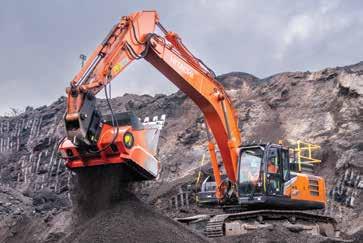
ALLU’s Asphalt Bucket is an attachment for 25-45-ton excavators and 15-30-ton loaders, designed for crushing and screening cold-milled asphalt and RAP in a single pass with a hybrid blade setup.
more profitable way to work, and we’re proud to help drive this transformation across the industry.”
The asphalt bucket uses a hybrid configuration of screening and crushing blades to process cold-milled asphalt directly at the source without additional crushing equipment.
“The hybrid blade setup is what makes this bucket so effective—it delivers just the right mix of crushing force and fine screening to process asphalt efficiently in a single step,” Grönholm said.
The bucket can produce over 95% of finished material below target size with nominal screen sizes of 12, 16 and 25 mm, according to the manufacturer. It reduces reliance on mobile impact crushers and delivers up to 250 tons per hour production.
Learn more at https://allu.net/products/asphalt-screening-bucket/
Astec Industries, Chattanooga, Tennessee, pulls from its 16 brands to design and manufacture the thousands of products used to build the infrastructure that physically connects the world. At the 2025 World of Asphalt tradeshow in St. Louis, Astec announced its Dropzone loadout solution.
Asphalt plant operators juggle multiple tasks including running the plant, coordinating with truck drivers, managing production and handling transactions. A misload can cost thousands in damages, medical expenses or downtime. Dropzone helps the operator ensure that the truck is in place, and that material is not being loaded where it shouldn’t be, thus safeguarding drivers, equipment and operations.
A spokesperson for Astec stated, “It helps prevent costly or unsafe loading situations. Dropzone is an operator aid in that it identifies if the truck bed is in the proper location for loading, but the operator still initiates the loading.”
The technology works with Astec controls or as a standalone solution for non-Astec systems. “Depending on the loadout system being used, the loading of the truck from there can be automated to meet a

target weight,” the spokesperson shared. “Our loadout systems do this, for example. If the truck were to start moving after the loading is started and the bed is detected to be moving out of the target, the Dropzone system will automatically close the gates.”
Workers can bypass the system without disrupting operations. “There is a manual override option in case they are doing maintenance or needing to load into something out of the ordinary. When the

override is done, the user credentials are logged, a reason code can be stored, and a recording is also stored.”
Learn more at https://www.astecindustries.com/
Bergkamp, Salina, Kansas, boasts decades of experience in slurry and microsurfacing solutions. In June 2025, the company announced its Journeyman Mobile Mix Plant, which is the company’s first entry into the cold central plant recycling (CCPR) market.
State departments of transportation (DOTs) have performed demo projects with CCPR treatments—check out a handful of articles on TheAsphaltPro.com like the recent “CCPR in Indiana” and “Central Plant Recycles it Cold”—to gain a cost-effective, sustainable solution for pavement rehabilitation.
The process begins by milling reclaimed asphalt pavement (RAP) from a roadway and, typically, storing it in a nearby stockpile. Once subgrade treatment or stabilization is complete, a pugmill at the stockpile site blends the screened RAP with an asphalt emulsion (or foamed process) to create the CCPR mix. This mix is paved on the nearby stabilized base.
Scott Bergkamp, president of Bergkamp, said the new Journeyman unit is “built to make CCPR more intuitive, more consistent and more reliable from day one.”

The ALLU Asphalt Screening Bucket is built for screening and crushing cold-milled asphalt and reclaimed asphalt pavement (RAP). It crushes clumps, screens fine material, and separates oversized particles in a single pass. The hybrid blade setup delivers the right crushing power with efficient screening. It reduces the need for impact crushers, cutting fuel use, wear part costs, and operating hours.
Whether you’re processing 100 or 250 tons per hour, ALLU helps you optimize your recycled asphalt handling. www.allu.net





“The ALLU Asphalt Bucket is much more efficient, productive and less expensive than bringing a mobile crushing plant on to the work site, essentially it does the same job for less than a top-ofthe-range mobile crusher. They are easy to use and much easier to maintain and they enable us to access restricted sites where we might not be able to bring in a separate crusher unit.”
Tom Chapman, Director MRD Plant, United Kingdom
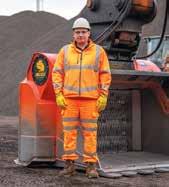


TOP: The Journeyman Mobile Mix Plant has emulsion and water ports on both sides of the plant. BOTTOM: The Journeyman Mobile Mix Plant from Bergkamp is rated at a maximum capacity of 275 tons per hour production, depending on mix ratio variables, and features an aggregate hopper of 8 feet, 7 inches (10 cubic yard capacity).
To achieve that goal, Bergkamp began its development process in 2017, building and testing an early prototype to validate performance and operator experience. Rather than retrofitting existing equipment, the team refined the concept, drawing on the success of its EMCADS control technology and input from contractors and operators.
The result is a machine that integrates proprietary automation and metering controls to reduce calibration time. It brings flexibility and precision to the job site, capable of producing mixes with 100% RAP, 100% virgin aggregates or a blend in between, according to the manufacturer. Aggregate and/or RAP is fed into a 10-cubic-yard-capacity hopper at one end of the unit. A conveyor sends this material into a pugmill. A 208-horsepower engine powers hydraulic pumps, and hydraulic motors power all the functions. The pugmill discharges the material into a stockpile.
Bergkamp explained the entire mobile plant can be hauled to a site behind a semi-tractor without the need for wide-load permits or other delays. The contractor can take the unit directly to an agency’s stockpile or their own, set it up and get to work.
“You can set this up in an hour or less at the stockpile site and start working,” Bergkamp said.
This plant is serving the needs of contractors who need to repair or reconstruct roads in remote locations.
“We see so much potential for CCPR,” Bergkamp said. “Now contractors can take a plant without any permits, without any wide-load signs because it’s as easy to move as any other semi-trailer, and perform in remote areas.”
The company plans to have a unit on display at CONEXPO-CON/ AGG 2026 but it is available for the North American market now.
Learn more at https://www.bergkamp.com/products/journeymanmobile-mix-plant.
Blue Diamond Attachments LLC, Knoxville, Tennessee, announced in February 2025 its new line of self-leveling Extreme Duty Series 2 cold planers designed for road surface milling, concrete scarification and asphalt removal applications. The comprehensive line includes eight models ranging from 14 to 48 inches in milling width, compatible with skid steer and compact track loaders, and the attachments are available in both low and high flow.
The new cold planer line features several design elements to enhance performance and precision:
• A patented self-leveling system designed to ensure constant milling depth regardless of ground contour or machine position
• Independent right and left depth adjustment capability, available in both mechanical and hydraulic configurations
• Standard hydraulic side shift functionality for flush milling against walls and other obstacles
• Multiple drum options with different widths and teeth layouts to accommodate various applications from asphalt to concrete milling “Our Extreme Duty Series 2 cold planer line represents a significant advancement in road maintenance and construction capabilities for contractors and municipalities,” said Drew Truan, COO at Blue Diamond Attachments. “By combining precise depth control with exceptional stability and versatility, we’re enabling operators to achieve superior results across a wide range of applications, from pothole repair to complete surface removal.”
The cold planers feature milling depths from 4.3 inches to 6.7 inches, depending on model, and working speeds of up to 16.4 feet per minute. All models have an optional dust suppression spray system and clear

The self-leveling cold planer attachments from Blue Diamond are designed to mill depths from 4.3 to 6.7 inches working at speeds of up to 16.4 feet per minute and feature an optional dust suppression system.
depth indicators for precise control. The line’s also features direct-drive hydraulic motors.
Learn more at https://www.bluediamondattachments.com/coldplaner?ref=bdaplaners.com
BOMAG’S BW 177 BVO-5 PL
BOMAG Americas, Ridgeway, South Carolina, boasts worldwide compaction and roadbuilding experts for soil and asphalt applications offering a broad range of product segments that consist of asphalt pavers and milling machines, reclaimer/stabilizers, single drum and tandem vibratory rollers, pneumatic tired rollers, landfill refuse compactors and a full range of light compaction equipment. Jan. 23, 2025, the company launched the BW 177 BVO-5 PL single drum roller featuring three compaction modes—high and low amplitudes, plus oscillation.
Some work sites require a gentler touch. For sensitive compaction work close to buildings, over pipelines and the like, BOMAG now offers the BW 177 BVO-5 PL. A single rotary dial allows the operator to select compaction modes and adapt machine output to site conditions. Offering a 140.8-pound/inch static linear load, the machine’s high amplitude delivers 33,720 pounds centrifugal force to compact lift thicknesses reaching 31.5 inches for rock fill, 19.7 inches for mixed soils. With its 66.5-inch wide drum width, the new BW 177 BVO-5 PL delivers up to 968 cubic yards/hour of compaction output, depending on material type and compaction mode.
Its dual pump system plus self-locking differential allows the machine to achieve up to 60% gradeability in forward and reverse, making it perfect for steep terrain projects, according to the manufacturer. Its articulating/oscillating joint provides +/-12º oscillation, ensuring the drum stays in contact with material when working in poor underfoot conditions.
Leveraging ECOMODE operation, the new single drum roller keeps the engine running at the optimum RPM range at all times for up to 30% fuel savings, according to the manufacturer. Further helping to reduce fuel consumption and lower wear costs, available BOMAG ECOSTOP technology automatically switches off the engine after 5 to 15 minutes of idling with shut-off time adjustable by the operator. A single lever allows the operator to control machine forward/reverse travel direction at speeds reaching 10 mph. Equipping the new roller with optional BOMAG TERRAMETER and BOMAP technologies helps to eliminate
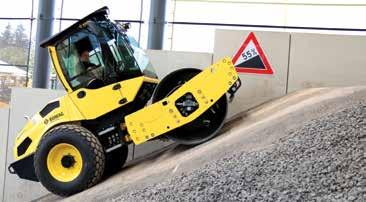
unnecessary passes to improve compaction efficiency and reduce overall costs. TERRAMETER uses two sensors to measure material stiffness, alert the operator in real time when compaction is achieved and ensure weak spots are detected. Regardless of roller brand, the available BOMAP app provides monitoring of compaction progress in real time.
Learn more at www.bomag.com/us-en
CM Labs Simulations, Montreal, Quebec, offers realistic simulation-based heavy equipment training solutions. With more than 25 years of experience, numerous awards, and 300+ academic papers to its name, CM Labs has achieved worldwide recognition for the quality of its solutions. March 12, 2025, the vendor launched the Intellia Single Drum Roller Simulator Training Pack, the industry’s first single drum roller simulation training.
While AsphaltPro Magazine has shared information on the company’s training solutions since 2019, this is the first training pack that focused entirely on soil and asphalt compaction. It integrates with CM Labs’ Intellia training platform and joins a robust equipment catalog for training operators of all levels.
Built by industry-leading subject matter experts and designed to address the growing labor shortage, the new training solution delivers a highly realistic training experience tailored to beginners who may have no prior experience operating heavy equipment. The Single Drum Roller Simulator Training Pack features a comprehensive nine-exercise curriculum designed to build a strong foundation in operating heavy equipment. With the training pack, trainees learn the foundational lessons of turning on, shutting down, and operating the roller, as well as more advanced lessons such as compacting dirt in a J pattern, compacting in a Y pattern, and how vibration settings affect operations.
“Because rollers are often the first piece of heavy equipment operators learn, we wanted to design a training solution that starts with the very basics of operation,” said Alan Limoges, the manager of product growth and partnerships. “Even if a trainee has never operated heavy equipment before, our Roller Training Pack can meet them where they are and bring them up to proficiency quickly.”
Learn more at https://vimeo.com/1040382465/2d794b532d?share=copy


The CP28 pneumatic tire roller from Dynapac is equipped with a watertight frame that allows for a flexible ballast system, letting operators adjust the weight as needed for the job.
Dynapac North America LLC, Fort Mill, South Carolina, is a supplier of soil and asphalt rollers, compact equipment, pavers, and feeders. The company places a strong emphasis on technology, sustainability and customer satisfaction as a partner in building the world’s infrastructure. March 25, 2025, the company introduced its CP28 Pneumatic Tire Roller to the North American market.
Asphalt contractors performing highway, bridge and sensitive paving projects look to tried-and-true technology to achieve perfect densities. The kneading action of the rubber-tire roller cannot be ignored for its ability to assist in meeting specs.
According to the manufacturer, the CP28’s flexible rubber tires and adjustable air pressure system allow operators to achieve consistent density while minimizing surface damage. The roller is made for various applications, including finishing asphalt layers to create a smooth, even surface with best-in-class tire overlap. It also excels at compacting different soil types, from granular to semi-cohesive materials.
One of the CP28’s standout time-saving features is the Air on the Run system, which inflates all tires from 0 to 120 psi KPa in 12 minutes. The CP28 features front and rear suspension systems designed to optimize tire-to-surface contact.
The CP28 is equipped with a watertight frame, allowing for a flexible ballast system. Operators can adjust the weight by adding or removing steel plates in the front and rear ballast compartments using a forklift. For even greater flexibility, the machine can be ballasted with wet sand, water, steel shot or scrap metal.
“The CP28 was designed with contractors in mind—offering a balance of power, precision and operator comfort,” said Eric Booth, the compaction product manager at Dynapac. “Its advanced features, like the Air on the Run system and enhanced suspension, ensure optimal compaction results while improving job site efficiency.”
Learn more at Dynapac.com.
Dating back to 1859, GEHL, Madison, South Dakota, has been deeply rooted in agriculture. Many years later, the company now offers products worldwide and partners with farmers, construction workers
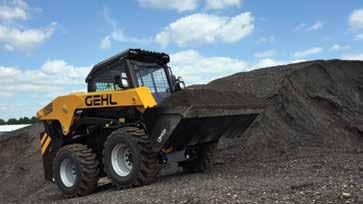
and track loaders that can assist asphalt professionals with up to 82 horsepower of hydraulic boost, smart load-sensing technology, and more.
and landscapers—large and small—to help move mountains. Aug. 27, 2025, the company introduced its all-new lineup of large-frame skid steers and track loaders for North America via an exclusive live product launch event where asphalt professional Marvin Joles, owner of Wis-Coat Asphalt Maintenance, shared his thoughts after trialing the machines with the audience. Joles spoke of the ease of operation like “a video game” and joined the GEHL team for a live Q&A here: https:// youtu.be/NLg-tsJEwC0?si=tAWDjwcvvx_asc2C
By providing a larger-capacity machine in the familiar skid steer category, GEHL is giving contractors equipment that remains in a compact footprint while offering more breakout force. The new series includes five models ranging from 3,250 to 3,600 pounds rated operating capacity, with optional side counterweights boosting capacity up to 3,800 pounds.
These machines offer up to 82 horsepower of hydraulic boost, high-flow auxiliary options, and smart load-sensing technology for improved efficiency and fuel savings. Each model has been tested with attachments like mulching heads, cold planers and snow equipment to ensure consistent performance in real-world conditions, according to the manufacturer.
• V325 Skid Steer – 72 hp, 3,250 pounds ROC
• V335 Skid Steer – 100 hp, 3,350 pounds ROC
• V360 Skid Steer – 114 hp, 3,600 pounds ROC
• VT335 CTL – 100 hp, 3,350 pounds ROC
• VT360 CTL – 114 hp, 3,600 pounds ROC
Learn more at https://www.gehl.com/en-US/new-line-large-frameskid-steers-track-loaders-0
Founded in 1986, HCSS, Sugar Land, Texas, is a provider of construction management software designed to connect the office to the field across the lifecycle of heavy civil and infrastructure projects. In Q1 2025, the company launched HCSS Insights, a solution that transforms raw data into actionable intelligence.
While the tool empowers heavy civil leaders with visibility across projects, it provides a foundation for streamlining workflows and improving overall efficiency for all manner of construction businesses
with data access. It integrates with other HCSS products that asphalt professionals use and benefit from.
“Newly launched HCSS Insights, available as part of any current HCSS product subscription, enables construction professionals to track costs, revenue trends, and budget allocation; monitor job progress, equipment utilization, and workforce efficiency; optimize fleet performance; and analyze safety trends to mitigate risk,” the software provider stated. “HCSS Insights is built on top of Power BI and integrates data from HeavyJob, HeavyBid, Safety, and Equipment360 to deliver more than 80 out-of-the box reports, allowing users to export and share reports, and subscribe to receive up-to-date data.”
In addition to HCSS Insights, HCSS is merging its suite of products into one unified platform. The unified platform enables users to quickly navigate between all HCSS products, improving productivity and streamlining workflows.
Learn more at hcss.com.
John Deere, Moline, Illinois, started nearly 200 years ago with a steel plow. Today, John Deere drives innovation in agriculture, construction, forestry, turf, power systems and more. March 12, 2025, the company introduced the SmartDetect Digital for select mid-size and largesize loaders; this is the digital license component that provides insights that job site managers can incorporate into their safety programs.
“At John Deere, we’re continuously innovating to help protect both the people operating our machines and those working around them,” said Katie Voelliger, product marketing manager, John Deere. “SmartDetect Digital underscores our commitment to leveraging obstacle awareness technology, providing fleet supervisors the ability to receive notifications in near real-time when an incident occurs.”
SmartDetect offers audible and visual alerts when objects, including bystanders, are detected behind the loader. It dynamically adjusts its alert system based on object proximity, escalating warnings as the machine gets closer to objects. With the addition of SmartDetect Digital, job site managers can respond more efficiently to job site layout and traffic. SmartDetect Digital builds on SmartDetect capabilities by integrating with the John Deere Operations Center™, unlocking even more features and offering more data reporting.
Learn more at https://www.deere.com.



The asphalt paver laser offers a guide for a consistent line for the paver operator to follow, shining vividly during daytime or nighttime operations.
Frank Foore, the proprietor of PaverLaser.com, formerly Asphalt Pokers, headquartered in Akron, Ohio, developed an asphalt paver laser for his own use in paving a consistent, straight line a few seasons ago. June 2025, he developed additional units and released the technology to the industry at large.
The device is just what it sounds like—a laser you attach to the asphalt paver to “point” at a straight line for the operator to follow.
“I made this for the paver to follow or else you’re painting lines all day,” Foore said.
To produce the units in larger quantities, he’s working on a plan and talking with factories to make that next step a reality.
Each paver laser comes in a waterproof briefcase with a 12-volt plug and a DC plug so it can be run off a generator. The case also includes a magnetic mounting bracket or clamp-style mounting bracket for the laser. Foore explained the magnetic bracket is perfect for the Vogele paver his crew runs and other brands; the clamp style will be ideal for the Cat paver other customers have discussed with him.
The asphalt paver laser itself is a guide designed to offer accuracy and ease of use for a consistent line for the paver operator to follow. From roads to parking lots to driveways, the laser guide provides a stable, unwavering reference without the risk of losing line of sight. It also helps to reduce trip hazards, contributing to a safer job site. The laser is equipped with a built-in cooling fan so it can handle the intense heat of paving operations.
Learn more at https://paverlaser.com/products/paver-laser

The TC 60 from ProStack features a length of 60 feet and a radial stacking option for those operations where space and mobility are concerns.
ProStack® is part of the Terex Corporation family, which is a global industrial equipment manufacturer of materials processing machinery, waste and recycling solutions, mobile elevating work platforms (MEWPs), and equipment for the electric utility industry. Earlier this year, ProStack unveiled a new range of tracked conveyors—the TC 50, TC 60 and TR 60. As vertically integrated asphalt contractors know, building and managing stockpiles is not a onesize-fits-all scenario. For small to medium-sized operations, the TW 36-150 (which is a 150-foot radial telescopic conveyor that ProStack introduced to the North American market this year and manufactures at the Terex facility in Mt Vernon, Missouri) may be more machine than needed. For the producers managing a little less material, the three conveyors in our Top Products feature offer a shorter conveyor length than the pre-existing ProStack range and deliver more choices.
The TC 50 tracked conveyor measures 50 feet. The TC 60 measures 60 feet. The TR 60 also measures 60 feet and offers a radial option. These models are engineered for efficient stockpiling in operations where space, mobility or budget constraints are key considerations.
“This new range allows us to fill a gap in our portfolio with conveyors that are better suited to smaller-scale operations,” said Neil Robinson, business line director at ProStack. “They’re compact, competitively priced, and tailored to meet the needs of a wider customer base.”
The new range is available globally through ProStack’s distribution network.
Learn more at http://www.terex.com/prostack.
ShoulderMaster, headquartered in Wauchope NSW, Australia, is a family business designing and manufacturing purpose-built road construction equipment with more than 35 years in the industry. In 2015 a combination of industry experience and innovation led ShoulderMaster to the development of the ShoulderMaster SM1500, Australia’s first universal skid steer/wheel loader shoulder paving attachment. During the World of Asphalt tradeshow in 2025, the company launched the CP1000 center paver.

The manufacturer states this universal skid steer attachment is “perfect for utility trenches and micro patching.” It is designed to minimize material waste and eliminate laborious hand work.
The CP1000 includes a wireless remote-control system and built-in cameras. It handles various thicknesses and widths of material—the screed width is 12.5 to 40 inches. The hopper capacity is 88 cubic feet and can be charged by a truck.
Features and Benefits Include:
• Ability to lay asphalt and gravel materials
• Chain driven, heat rated belt to withstand asphalt
• Wireless remote control for operator safety
• Wireless camera within cab monitor
• Hydraulically controlled screed height adjustment between 0 and 4 inches above pavement level at any width
• Universal skid steer attachment
Learn more at www.shouldermasterus.com
Skip-Line® is a provider of data logging and precision control systems for road striping and surface marking. Since 1926, Graco® has been a provider of fluid handling systems and components, offering solutions that enhance the performance and productivity of professionals in the construction, automotive and maintenance industries. March 28, 2025, the two partnered up to introduce a reflective bead application device for road striping operations: the ACCU-BEAD™ Flow Sensor for reflective road marking.
Commercial and subcontractors are aware of the need for a more efficient delivery system when it comes to getting reflective
lines down for a state or other specifying agency. The ACCU-BEAD Flow Sensor is designed to eliminate the need for traditional load cells by providing real-time monitoring of glass bead flow rates. It integrates with Skip-Line’s DL-18 Data Logger and the Spec-Rite Online platform, to offer contractors complete visibility and control over their road marking materials and application processes.
The system allows operators to monitor and adjust bead flow rates for each individual gun. This capability ensures that application rates align with specs, reducing the need for costly rework and enhancing compliance with road safety regs.
Advantages of the ACCU-BEAD system include real-time data monitoring, enhanced spec compliance and seamless integration through the Spec-Rite Online platform.
Learn more at https://skipline.com/accu-bead/
Founded in 2006, Sripath Technologies® LLC, Mahwah, New Jersey, is a global supplier of additives. Through an extensive network of affiliates, agents, and experts, Sripath develops, tests, and markets proprietary additives for the purpose of enhancing the properties of bitumen, asphalt mixes, and formulations. Sept. 11, 2025, the company launched the crosslinking additive, ButaPhalt®.
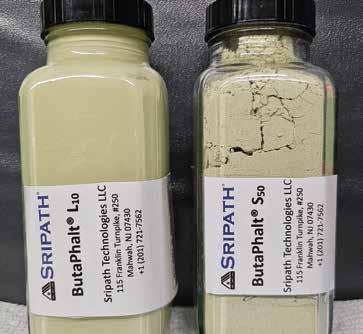




May 2025, Sripath acquired the “Buta Business” consisting of the assets of ButaPhalt Products LLC, ButaChem LLC, ButaMix LLC, and related businesses and activities. ButaPhalt is the first product of the Buta Business being offered under the Sripath banner.
ButaPhalt is a crosslinking additive that is engineered to improve the performance of polymer-modified bitumen (PMB). It allows sulfur to crosslink with the polymer during PMB production, which may help reduce the amount of polymer needed in a PMB mix to deliver desired performance. ButaPhalt is formulated from a proprietary blend of sulfur powder, accelerators, scavengers, surfactants, absorbing agents and specialty oils. The result is a product designed to be a more effective crosslinking additive as well as highly dosage efficient.
The manufacturer states: “ButaPhalt typically improves productivity, reduces processing time, and lowers operational costs. ButaPhalt is an operations-friendly product that is easy to use and safe to handle. It can reduce hydrogen sulfide (H2S) emissions and odor typically associated with PMB production. It helps improve working conditions while mitigating potential environmental impacts. ButaPhalt improves the thermal stability of a PMB. It easily delivers desired PMB performance.”
“From a technical perspective, ButaPhalt has been and continues to be a significant step forward in crosslinker technology,” said Dennis Krivohlavek, the business development specialist for Sripath Technologies. “Its proprietary formulation delivers greater stability, consistent performance, and enhanced ease of handling for producers. We’ve designed it to integrate seamlessly into PMB production, helping our customers optimize their processes while meeting stringent performance specifications.”
Learn more at www.sripath.com.
AN HONORABLE MENTION: BOMAG’S CR 820 T-2 RUBBER TRACK PAVER
Bomag’s 8-foot CR 820 T-2 rubber track paver on display during World of Asphalt 2025 also impressed with its 10-ton hopper capacity allowing extra time between truck exchanges. The 173-horsepower diesel

engine is designed to push all that weight up steep grades. Another aspect of the paver’s capacity is the Stretch 16 hydraulically extendable screed, which lets the team pave from 8 to 16 feet wide. A new operating system for each console offers easy viewing of critical operating functions, gauges, parameters and fault messages.
Learn more at www.bomag.com/us-en
AN HONORABLE MENTION: RELIABLE ASPHALT PRODUCTS’ AARC BLEND PRO 2.0 Reliable Asphalt Products Inc., Shelbyville, Kentucky, was founded in 2001 and today offers a broad selection of new and used asphalt plant equipment. A team of in-house technicians assists customers with everything from planning, designing and selecting to maintaining asphalt plant equipment. January 2025, the team launched its AARC BLENDPRO 2.0 asphalt plant control system. While this update was officially launched to the public in January, a spokesperson for the company explained it was taken from the original concept/development that had been made available and launched to customers previously.
The AARC BLENDPRO 2.0 provides control of all aggregates, recycle (RAP and RAS), fillers, additives, asphalt metering, exhaust fan air control, silo filling control, temperature monitoring, and all plant motor start/stop. The system administers multi-point belt-scale and feeder calibrations, production, calibration and inventory reporting, and an unlimited historical log of all system alarms. Online support and real-time online data are also available.
The system operates as a hard PLC-based system, meaning all inputs and outputs can be in a centralized location with switching handled by Siemens I/O modules that are controlled by a programmable logic controller (PLC) with an industrial-grade computer for the operator interface and database management. The AARC BLENDPRO 2.0 software operates as a closed-loop system.
Each installation of the software is fully customized for each individual plant.
One of the facets we found intriguing for contractors was that of the intuitive mix entry. The manufacturer explains how operators enter and update mix designs. “Mix designs are simple to add and update. We also keep track of the number of starts and stops of each mix, so the most used mixes are at the top of the selection list when starting up. The operator does not have to change screens to start a mix; they only

need to activate the ‘Start Mix’ Dialog and select the mix and rate, then click ‘Start.’...We have absolutely no limitation on the number of materials that can be used in the system.”
Learn more at https://reliableasphalt.com/aarc-systems-blendpro-2-0/
SAKAI America, Inc., Adairsville, Georgia, specializes in asphalt rollers, soil compactors, and light compaction equipment for the paving and construction site prep markets. March 10, 2025, the company released its new Echelon Mode for the Guardman® Automatic Brake Assist System. While the Echelon Mode can be considered an update, it still deserves a mention in the top products list due to its contributions to safety in the work zone.
The manufacturer states: “Guardman...utilizes millimeter-wave radar or 3D LiDAR (depending on the model) to detect potential collisions with personnel or equipment, warn the operator progressively, and automatically brake to prevent accidents if needed. The new Echelon Mode builds upon this foundation by specifically addressing the unique challenges of echelon rolling, a common technique used in highway-class paving.”
Echelon Mode allows two SAKAI asphalt rollers, equipped with Guardman, to operate in close proximity without generating false


alarms but still protecting against collisions, according to the manufacturer. The system intelligently monitors distance to the lead roller, ensuring that both operator warning and braking is only initiated when an imminent collision risk is detected.
Learn more at www.SakaiAmerica.com.













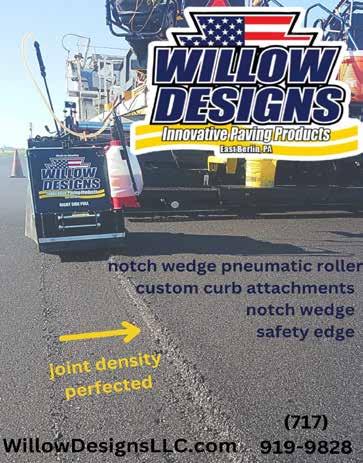




























The Associated Builders and Contractors (ABC) unveiled its 2025-2026 Tech Alliance members in September. This marks the fifth annual alliance. The alliance is a cohort of technology companies built to create construction technology solutions for the association’s contractor members, which primarily work in the commercial and industrial sectors.
“ABC’s Tech Alliance helps drive innovation throughout the association by helping our members develop their workforce, win work and deliver work that safely, ethically and profitably,” said Matt Abeles, ABC’s vice president of construction technology and innovation. “This fifth cohort plays a crucial role in delivering education to ABC members across the country through events hosted by our 67 chapters. Technology knowledge and adoption continues to grow among ABC contractors thanks to Tech Alliance members.”
The 15 companies comprising the 2025-2026 cohort are Arcoro, Autodesk Inc., BuildOps, Datagrid, Document Crunch, Egny-
te, Kojo, KPA, Sage, Sentriforce, Smartapp, SmartBuild, SubHQ, Stack and Trimble.
The Tech Alliance introduces small and midsized contractors and subcontractors to construction technology solutions for HR workforce management, project management, field service management, agentic artificial intelligence, contract compliance, cybersecurity, asset management, safety analytics, accounting, billing, job site security, estimating, takeoffs and reality capture, among others. Tech Alliance companies also collaborate on resources for ABC members, including beta testing, free technology programs and educational webinars, and provide ABC chapters with access to technology products used in the field by ABC contractor members.
In addition to the Tech Alliance, ABC also offers members its Tech Marketplace, which provides premier discounts for construction technology and innovative digital solutions. The Tech Marketplace is comprised of over 20 vetted companies that help ABC contractor members advance and grow their technology strategies, offerings and abilities.
For more information, visit abc.org/techalliance.
We’d like to take the opportunity to thank our readers, advertisers and team for making 2025 a great year!




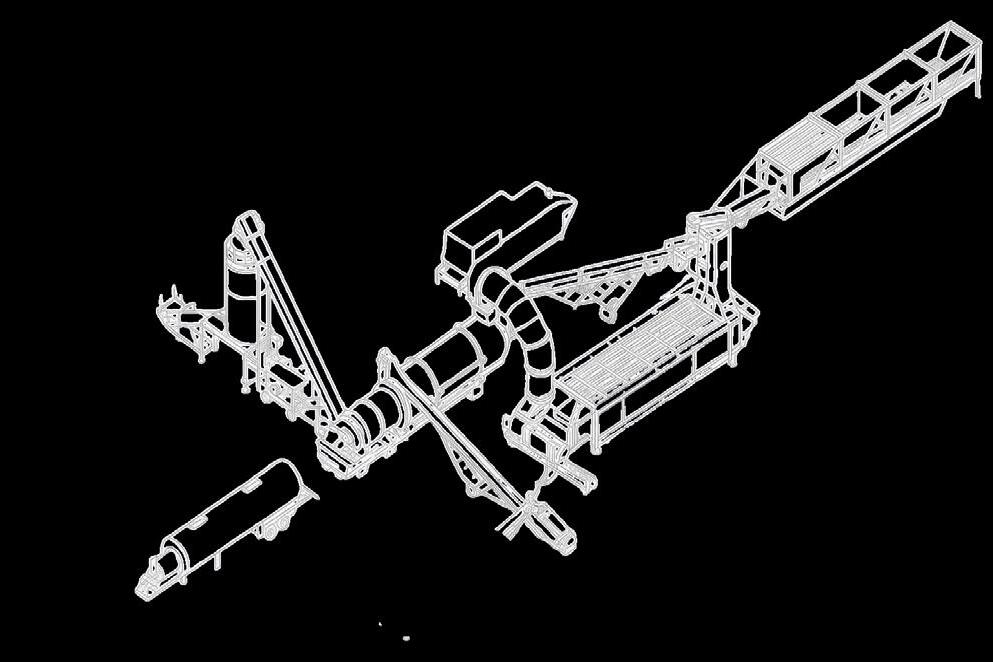
At CWMF, we don’t just build asphalt plant components — we build confidence into every job you take on. Our Tremor Shaker™ Scalping Screen is a perfect example: rugged Huck-bolted construction, eccentric flywheel design, and C-style shaker springs that keep production smooth, efficient, and low-maintenance.
Whether it’s the Tremor Shaker™, a Dust-Pilot baghouse, a Revolution D™ Drum Mixer, or a complete plant build, our team brings decades of craftsmanship and innovation to every project. Because at CWMF, every detail matters — and every detail is built to last. See the full CWMF lineup at cwmfcorp.com



BY RAQUEL MORAES, PH.D.
An article in the September 2025 edition of AsphaltPro regarding spray-on rejuvenators and nighttime application referenced research conducted at the National Center for Asphalt Technology (NCAT). While NCAT appreciates the industry’s enthusiasm for advancing pavement treatments, several points in the article require clarification to ensure the published information accurately reflects the work performed and the scope of involvement of both NCAT and the Alabama Department of Transportation (ALDOT).
Spray-on rejuvenators have been successfully applied at the NCAT Test Track both day and night, provided ambient and surface temperatures met the product specifications, typically 10°C (50°F) or higher, and surface conditions were suitable.
Curing time depends on dosage, pavement texture, permeability, and environmental factors, rather than on whether it is daylight or darkness. NCAT research has shown that, under proper conditions, both daytime and nighttime applications can achieve acceptable curing and reopening intervals.
The article referenced the 2018-2021 NCAT Test Track research cycle, during which two, not three, spray-on rejuvenators were evaluated on Section S3. This work was sponsored by the Mississippi Department of Transportation (MDOT). All applications occurred during daylight hours, following standard temperature and pavement condition criteria. The purpose of the study was to evaluate the performance of spray-on rejuvenators over time, not to test nighttime applications or new application systems. The claim that friction loss was due to the distributor application method is inaccurate; friction recovery after spray-on rejuvenator application depends on multiple factors, including formulation, dosage, and characteristics of the surface layer.
It is essential to distinguish between two separate efforts:
• NCAT Test Track Section S3 (2018-2021): Delta Mist was applied to a dense-graded asphalt surface to study binder rejuvenation over an extended period.
• U.S. 280 Small-Scale Evaluation (2023): Conducted at iEmulsions’ request, this was a limited laboratory-linked test assessing the short-term binder response of Delta Mist HR combined with an SBR-based polymer (UP-40) on an open-graded friction course (OGFC) surface.
These studies differed in materials, surface types, and objectives and should not be presented as equivalent or sequential experiments.
The April 2023 test near Auburn, Alabama, was designed to extract and analyze field cores from small, controlled test spots (approximately 2
feet × 5 feet) without affecting normal traffic (See Figure 1). All applications were conducted during the day using manual spraying, not the two-bar Smart Spray Technology (SST) system described in the article.
NCAT’s role was limited to applying materials and conducting a few rheological tests [complex shear modulus (|G*|), absolute viscosity (η*), and phase angle (δ)] at 60°C and 76°C on binders recovered immediately after treatment application, per the sponsor’s request. Test results confirmed short-term binder softening and increased phase angle, indicating rejuvenator-binder interaction, but did not assess long-term performance.
NCAT emphasizes that short-term softening alone does not predict durability or overall field performance; ongoing monitoring is required to make such conclusions. Importantly, ALDOT was not involved in this small-scale evaluation.
Friction was measured on the treated OGFC spots using a Dynamic Friction Tester (DFT), shown in Figure 1. Results indicated that friction values returned to neutral levels within two hours under the specific materials, conditions, and weather conditions during testing. These findings are encouraging but limited. They should not be generalized to broader pavement types or used to substantiate unrestricted nighttime application performance claims.
Subsequent field demonstrations of Delta Mist HR and the Smart Spray Technology system—conducted in Virginia, Arizona, and California— were organized by iEmulsions and partner organizations, without NCAT’s participation. NCAT’s involvement was limited to the April 2023 U.S. 280 binder evaluation, which was conducted entirely under daytime conditions and did not utilize the two-bar SST application.
NCAT supports efforts that advance asphalt rejuvenation technology and appreciates collaboration across research, industry, and agency partners. However, ensuring that publicly shared information accurately represents the scope, methods, and outcomes of each study is critical to maintaining scientific integrity and public trust.
Spray-on rejuvenators show strong potential to extend pavement life and increase maintenance flexibility. As research continues, NCAT remains committed to transparent data sharing and to helping the industry make decisions grounded in verified evidence.
Editor’s Note: AsphaltPro regrets any misinformation making it to print and has removed the article in question from our website. We want to thank the NCAT staff for providing clarification on a document that was submitted for publication in the September PreservationPro. We are thankful for the collaborative spirit bringing accuracy and transparency to this topic.
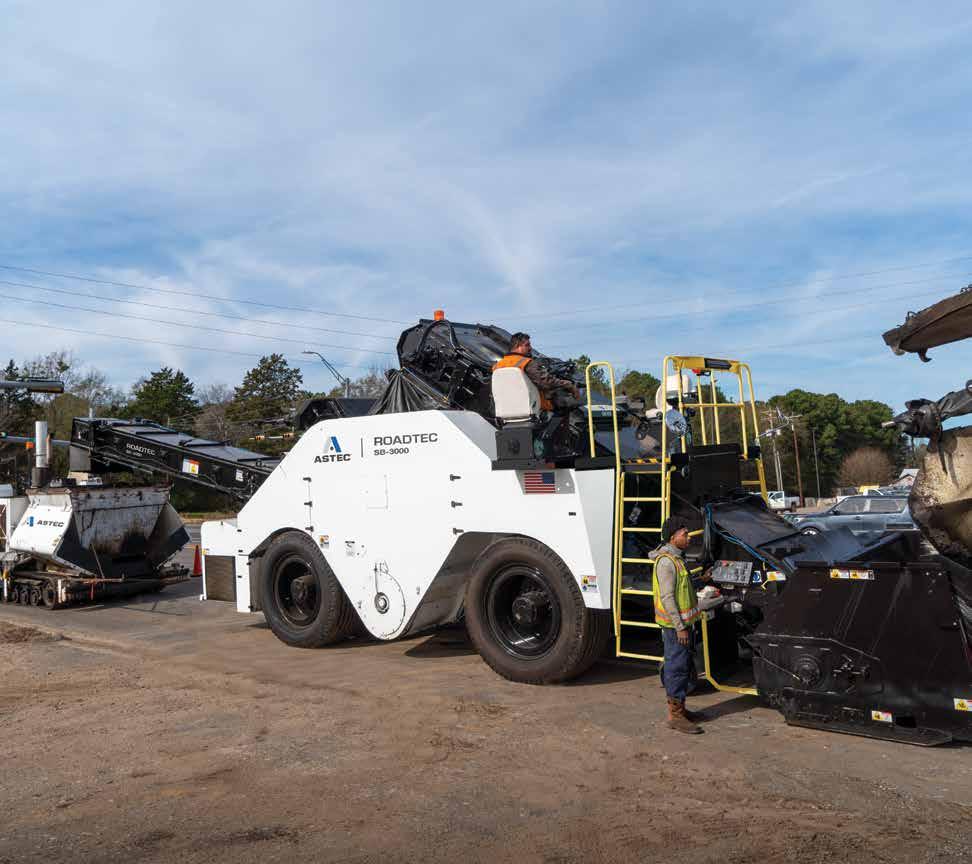

Astec revolutionized the paving industry with the introduction of the Shuttle Buggy, and now the SB-3000 sets a new standard in material transfer vehicles. Effortless maintenance, unmatched performance, and four steering modes for ultimate agility keep paving seamless. Experience groundbreaking innovation with the patented Ground Crew Control Station for the ultimate user experience and protection. The SB-3000 isn’t a machine, it’s a revolution in material transfer, built on Astec’s legacy of industry firsts.






